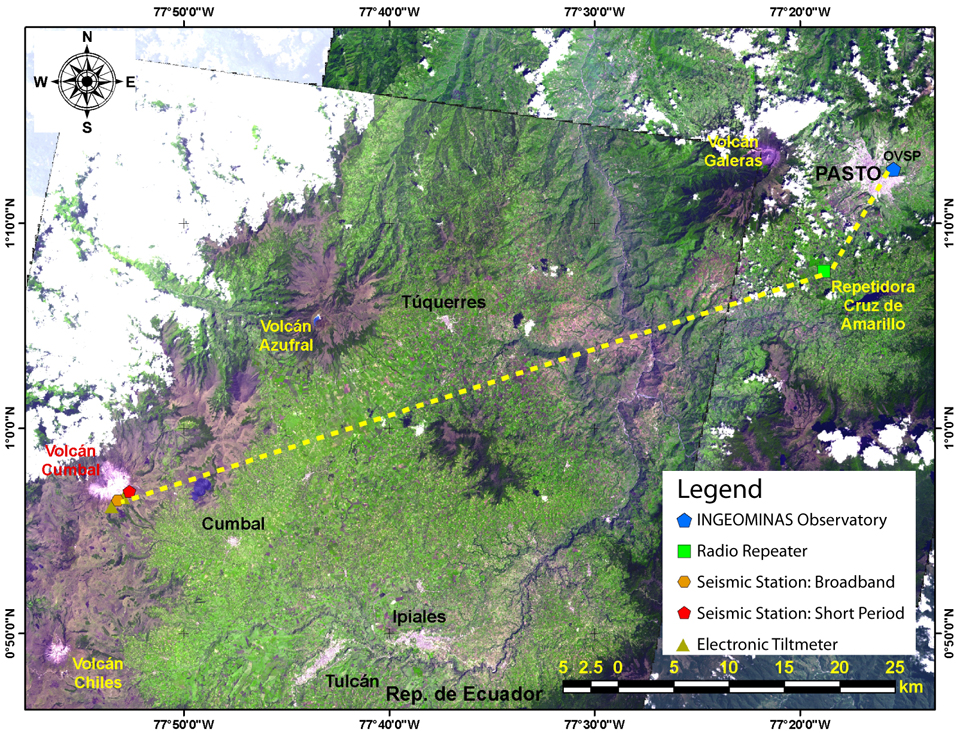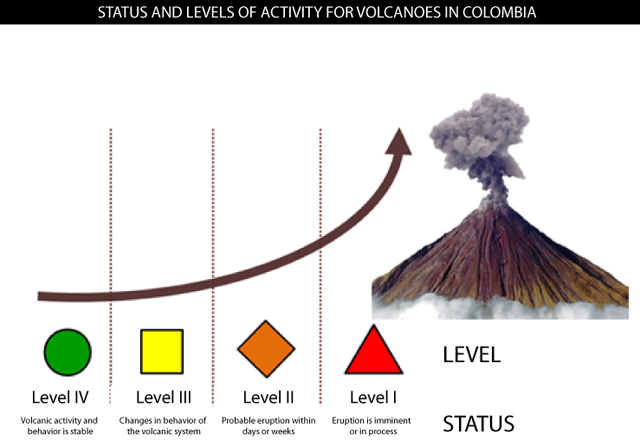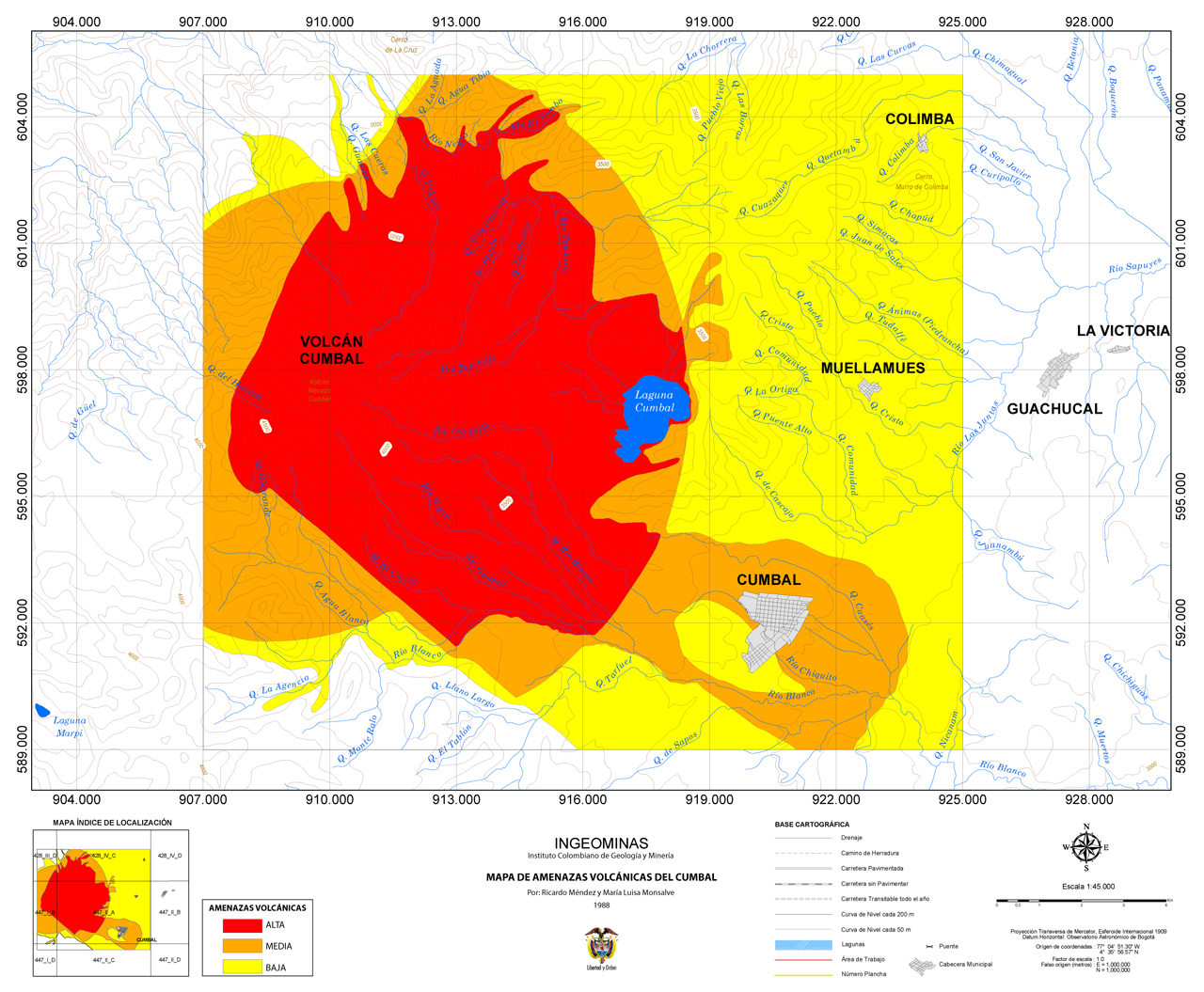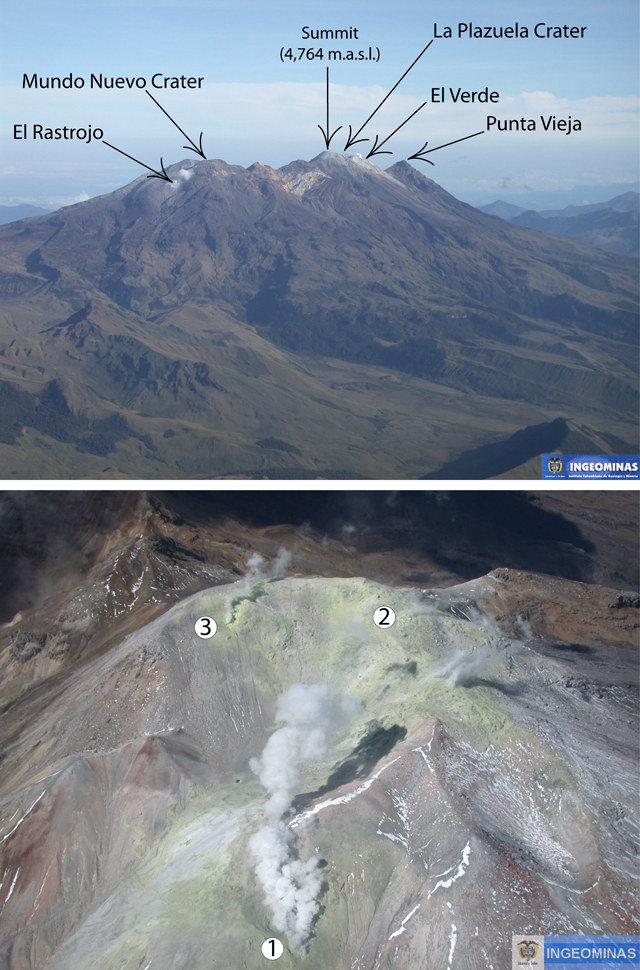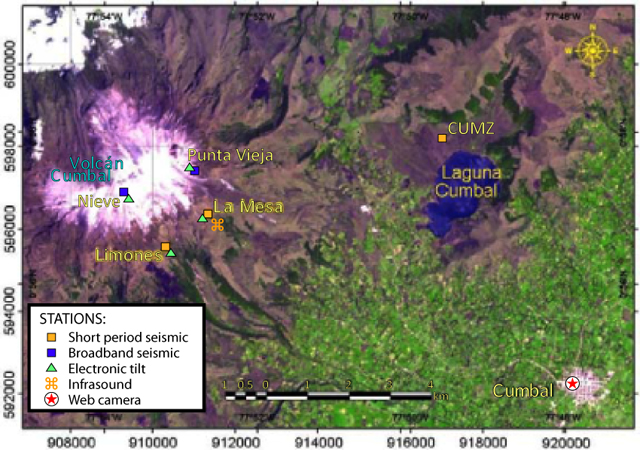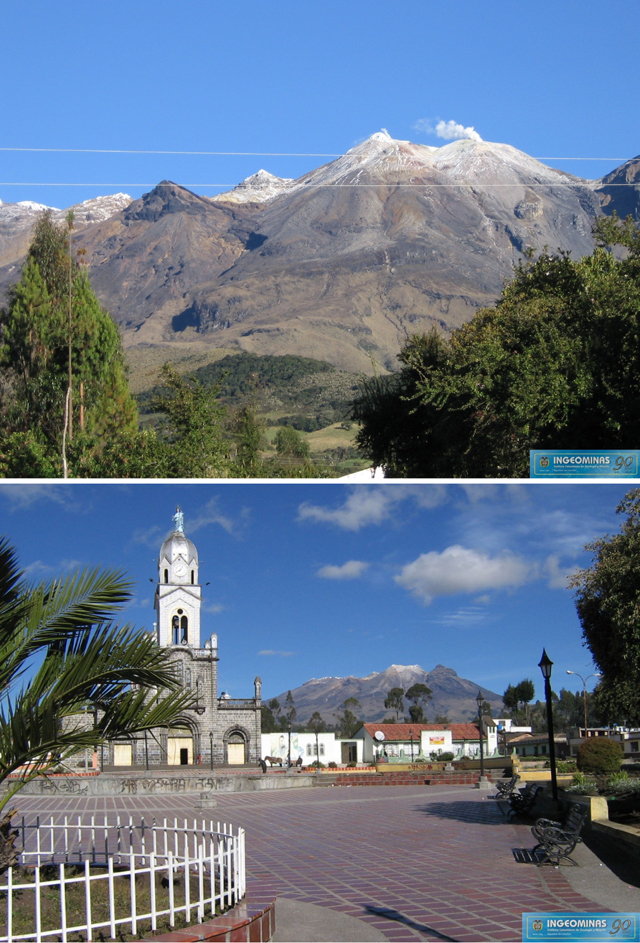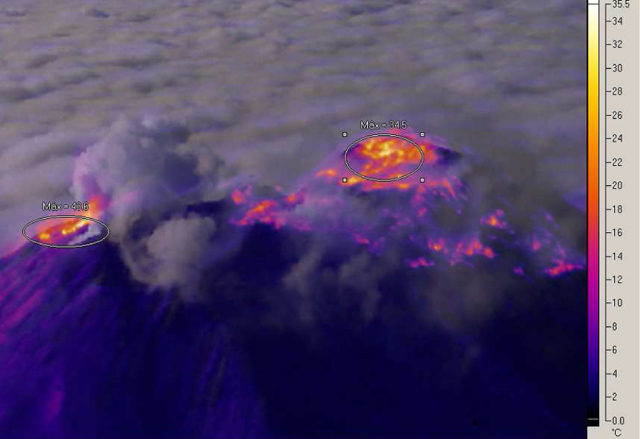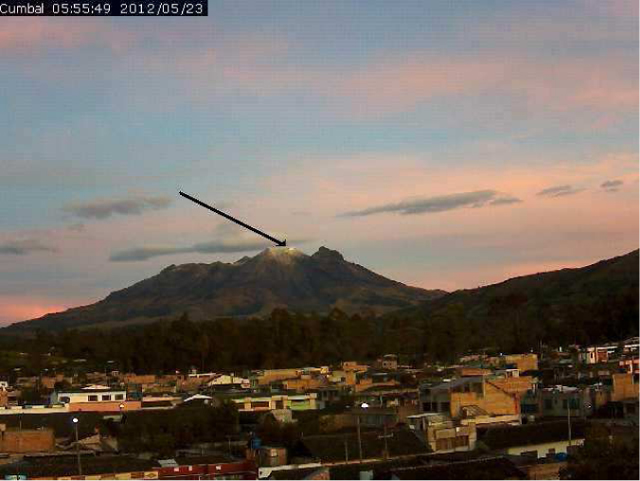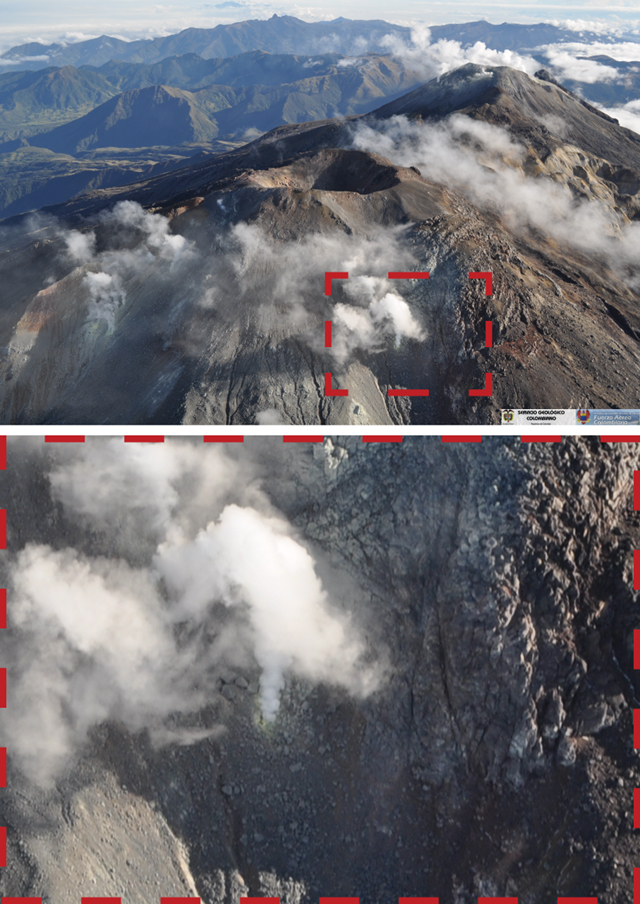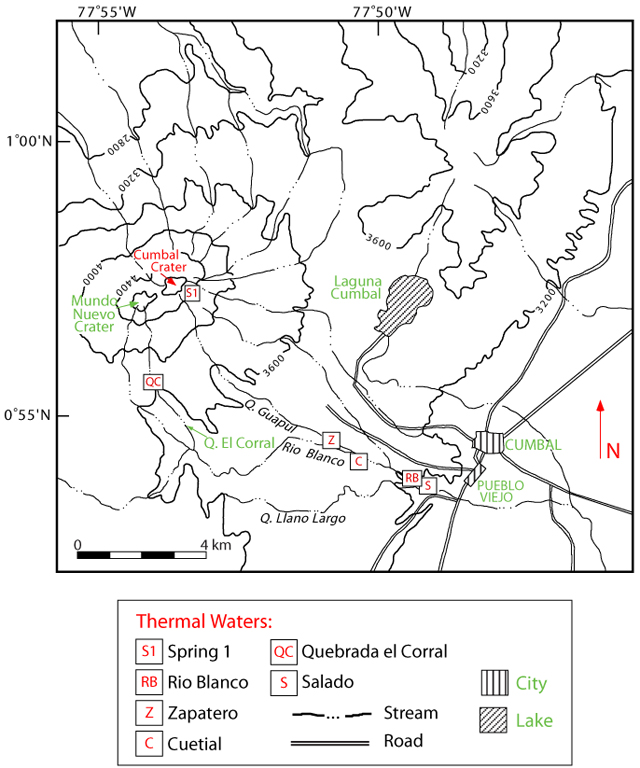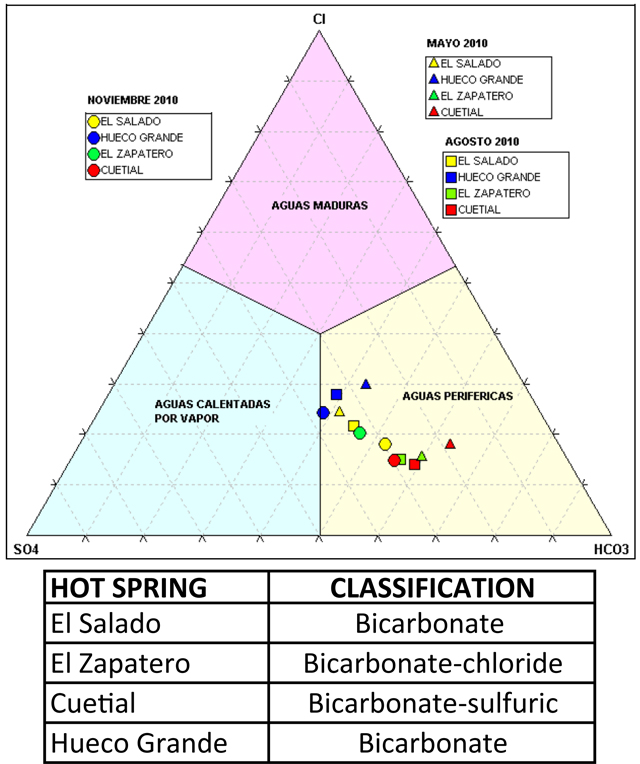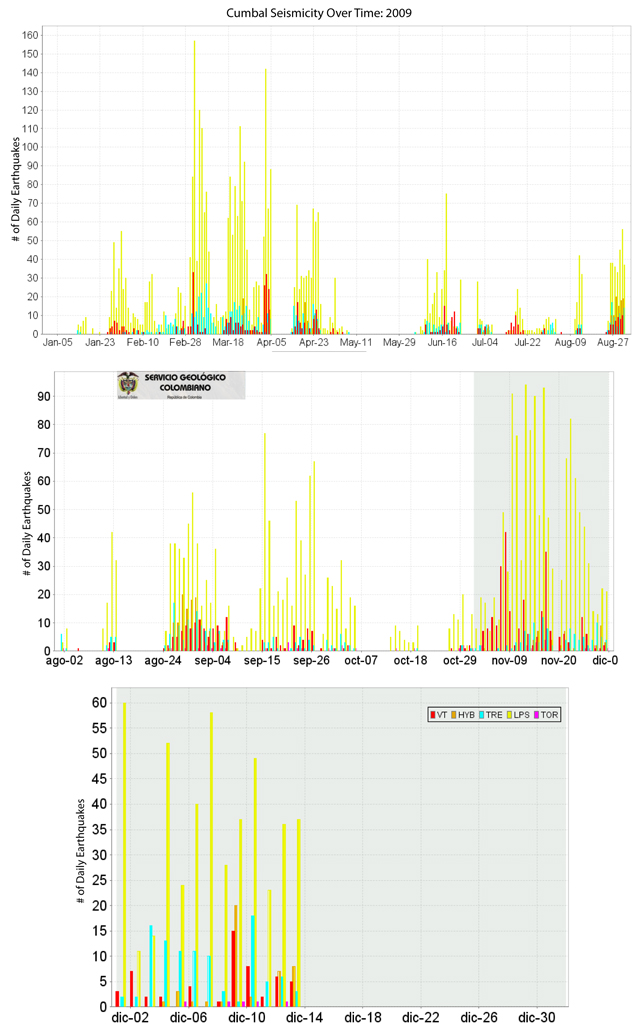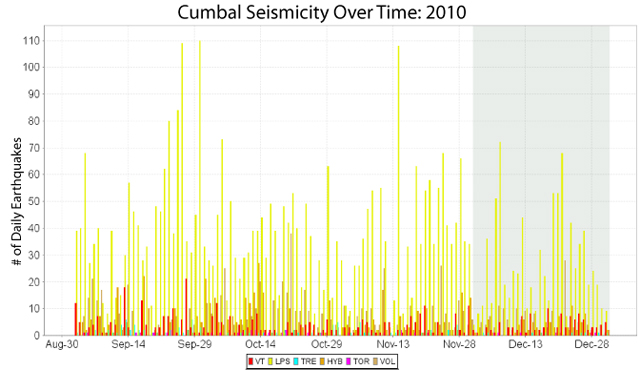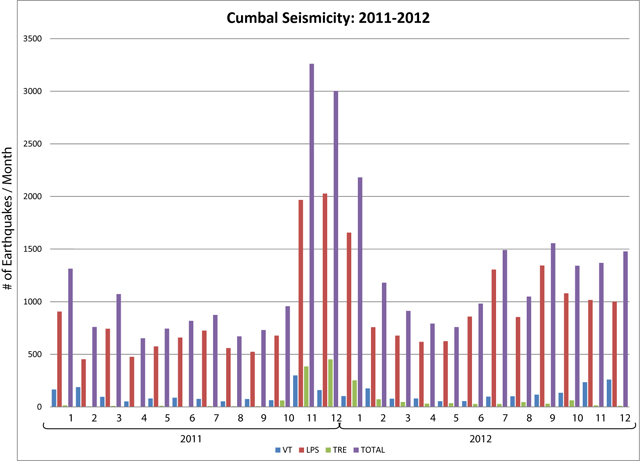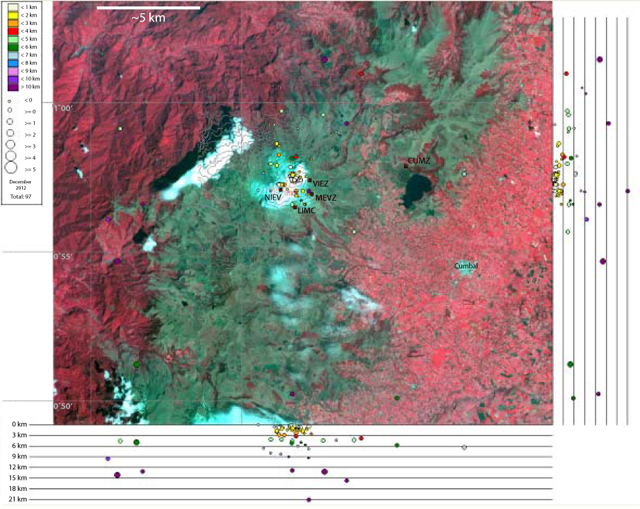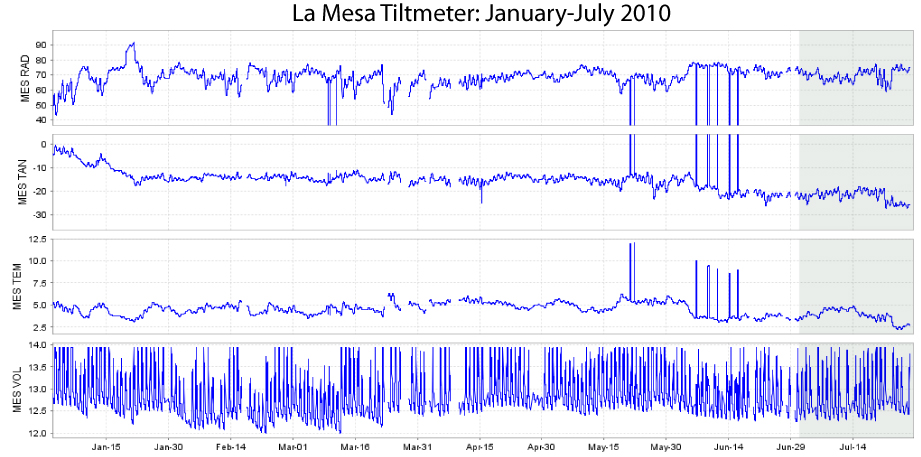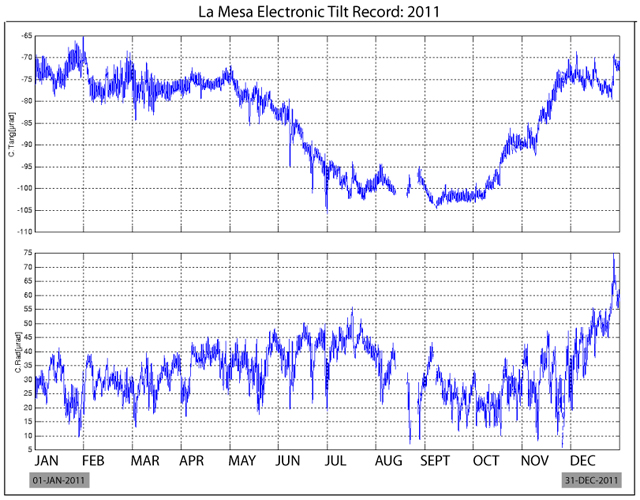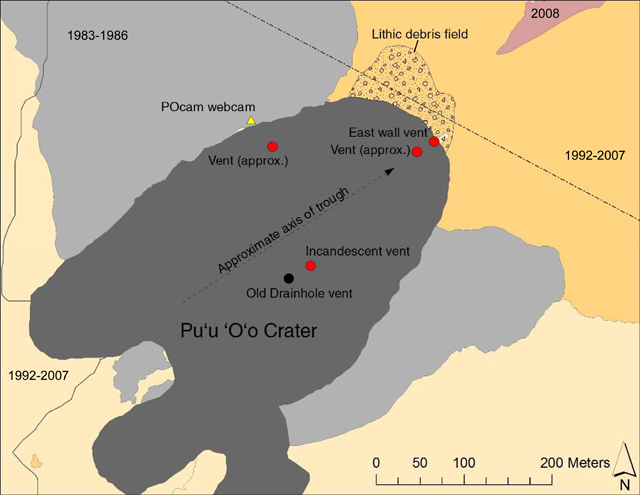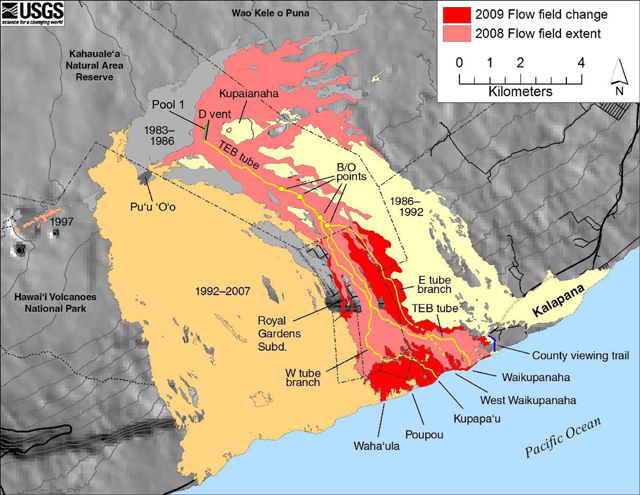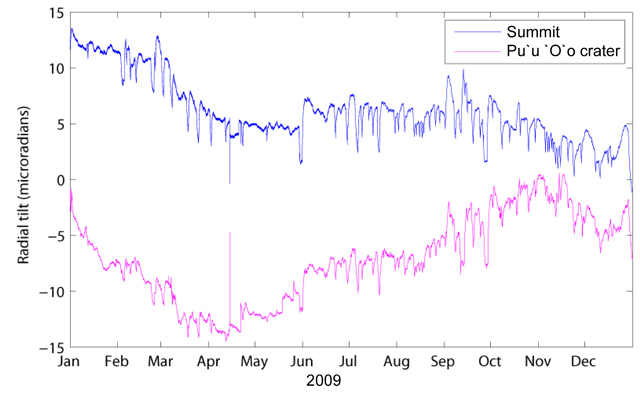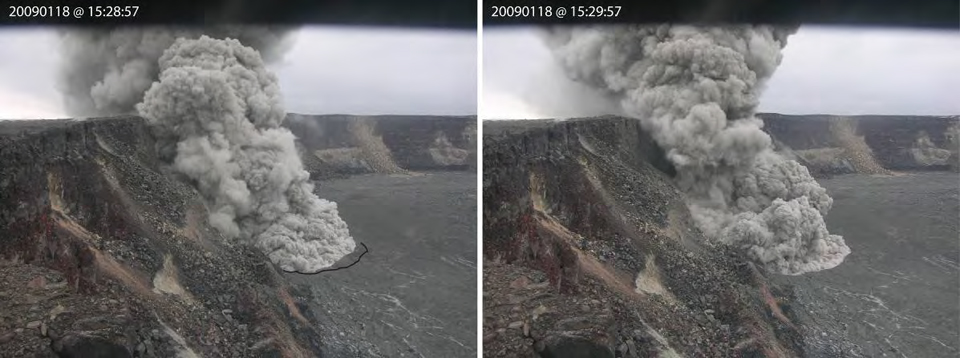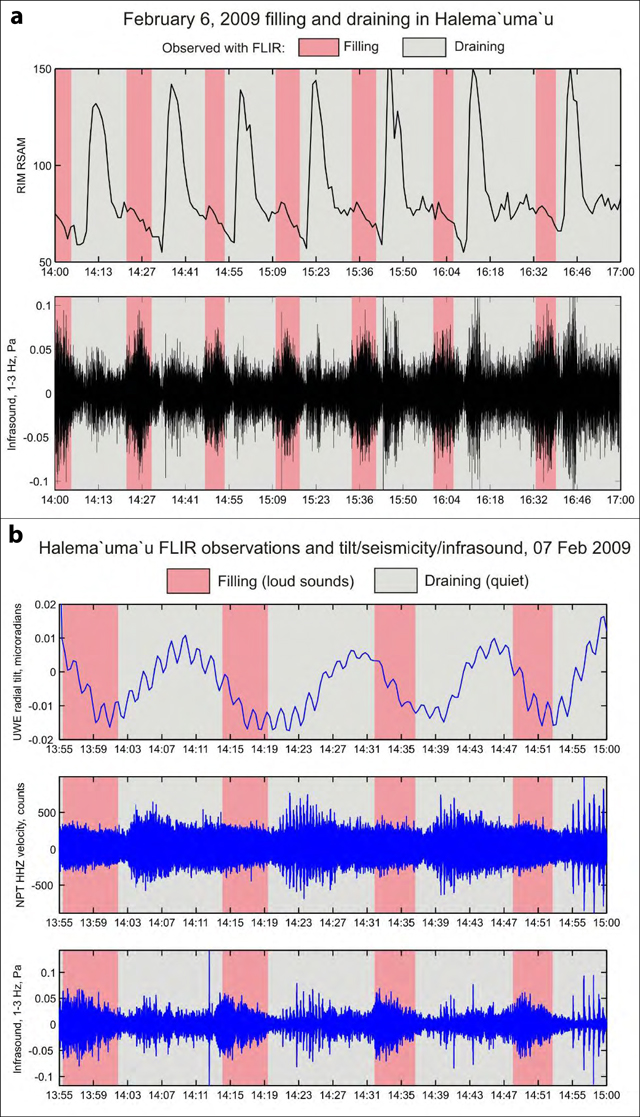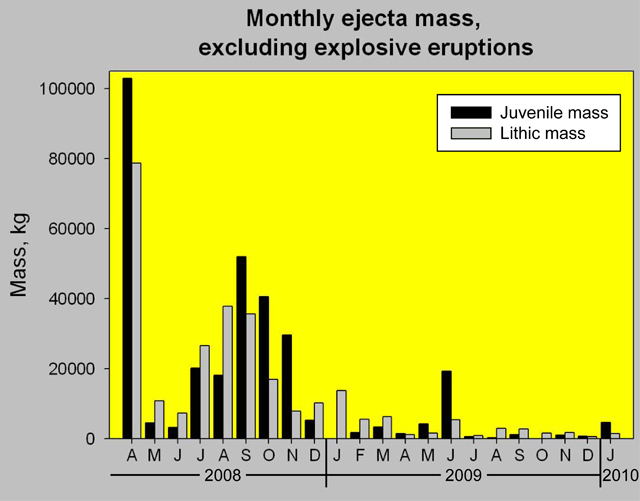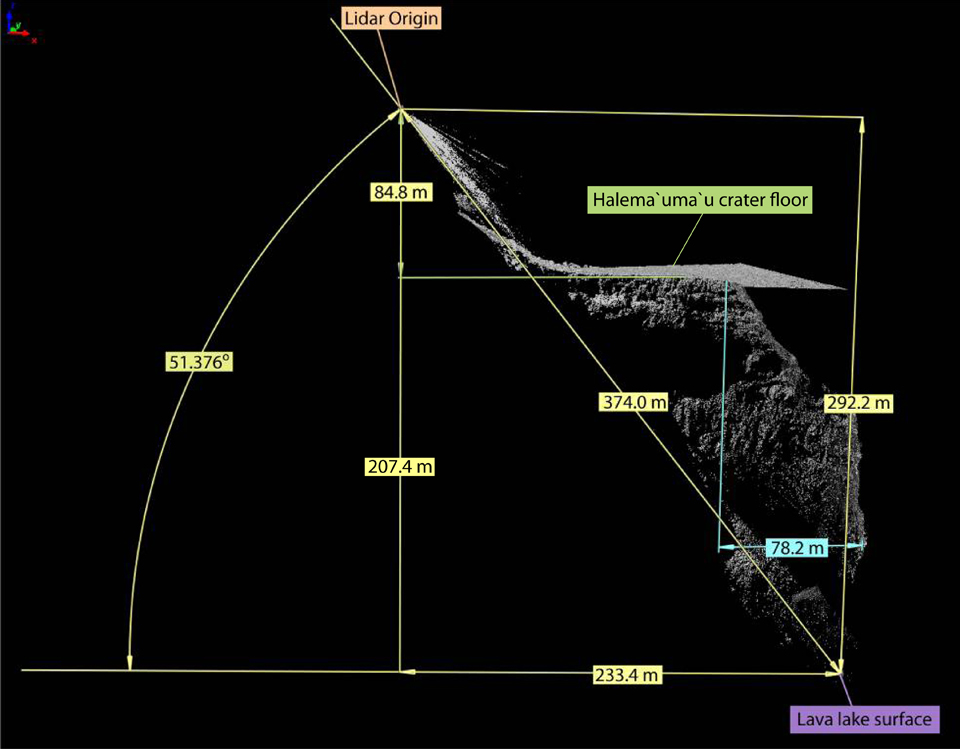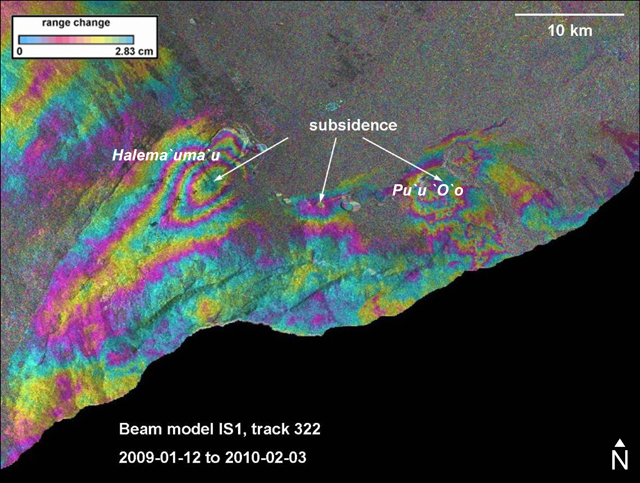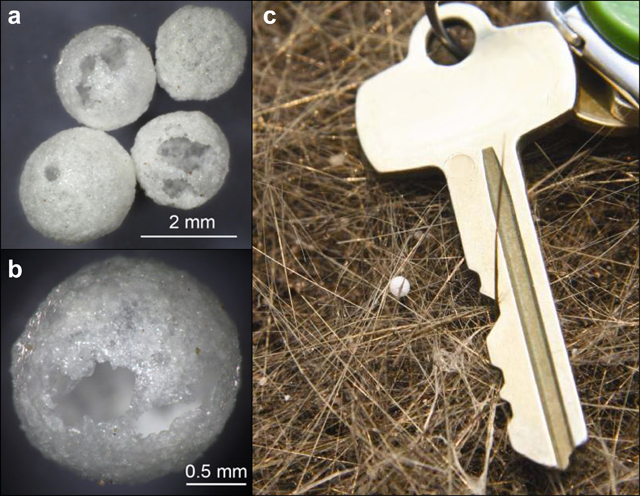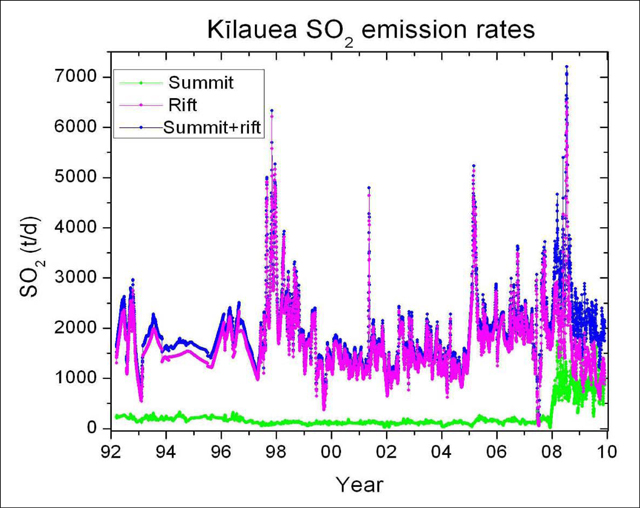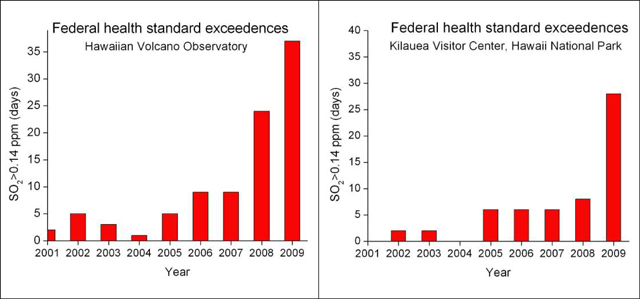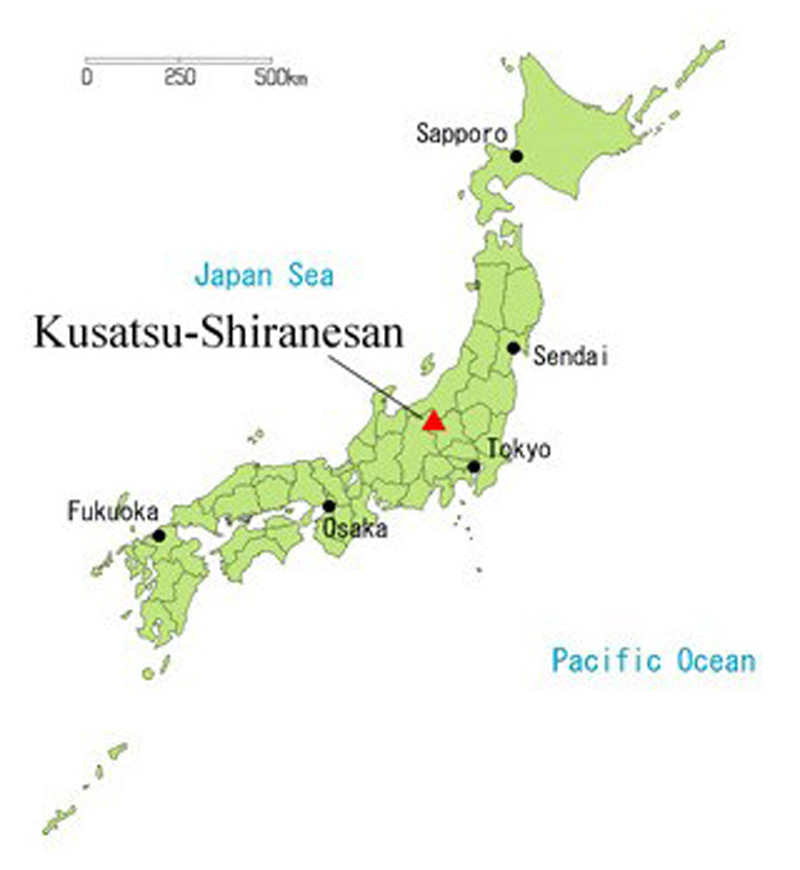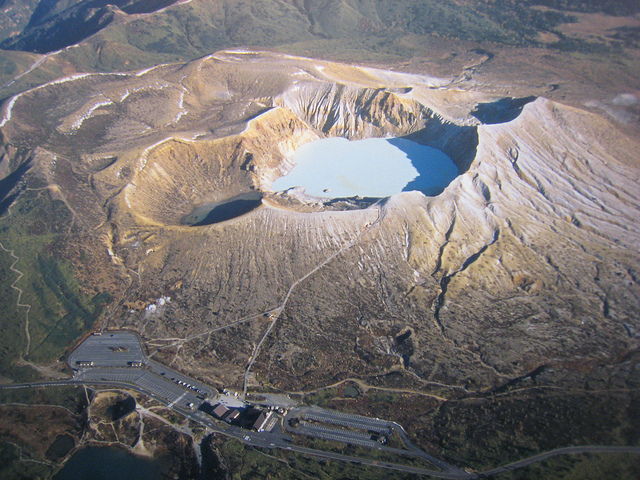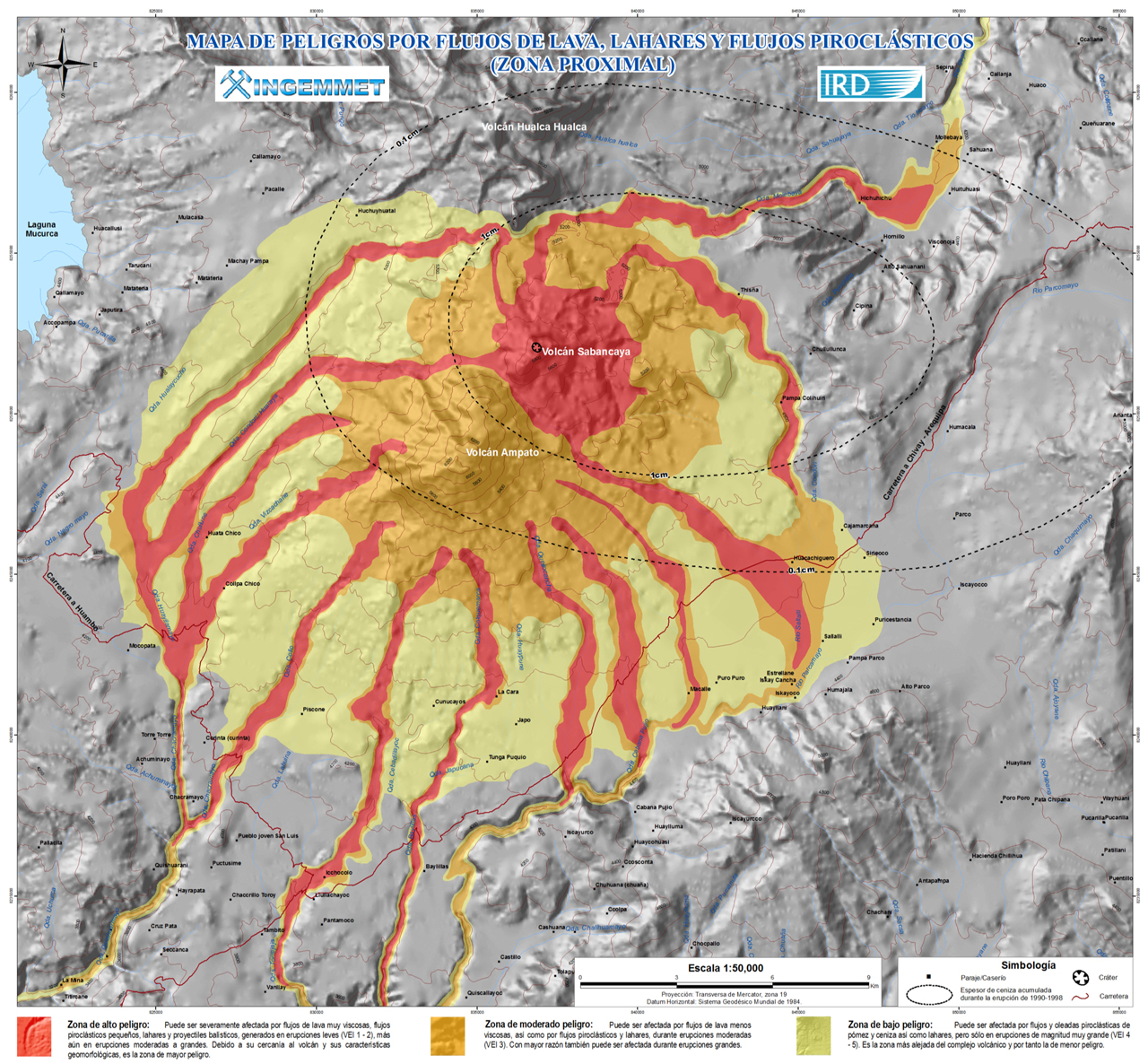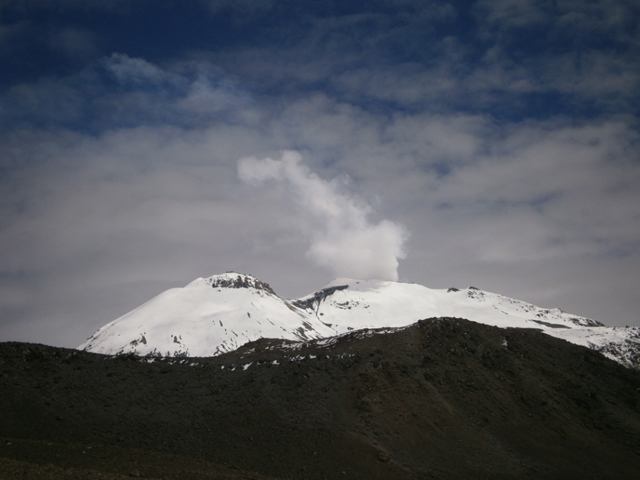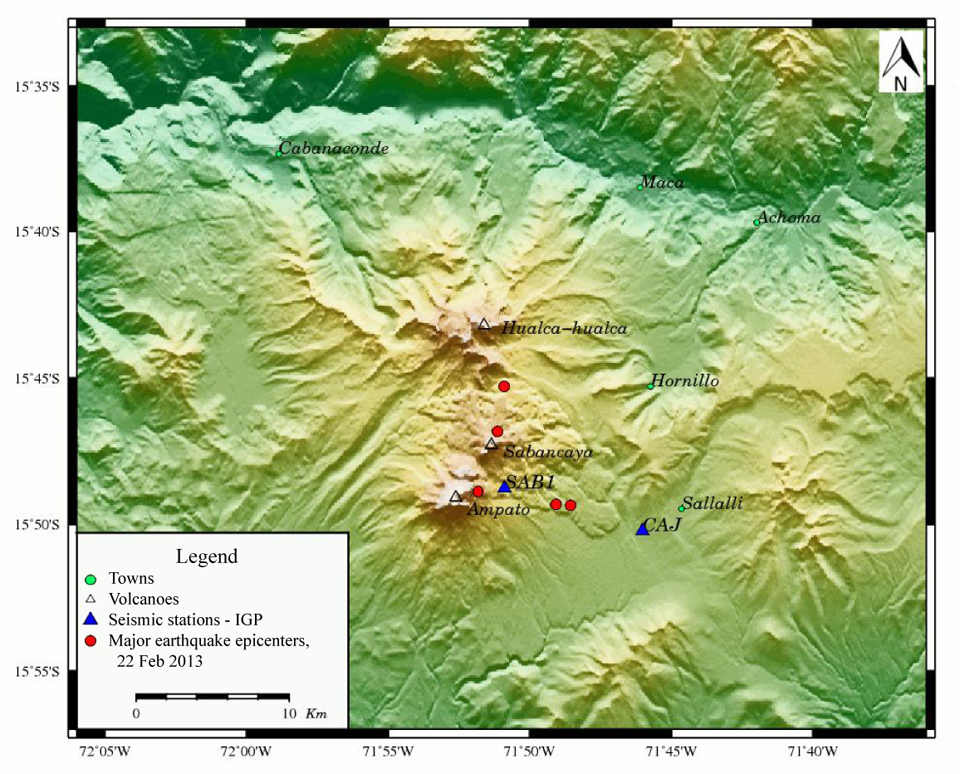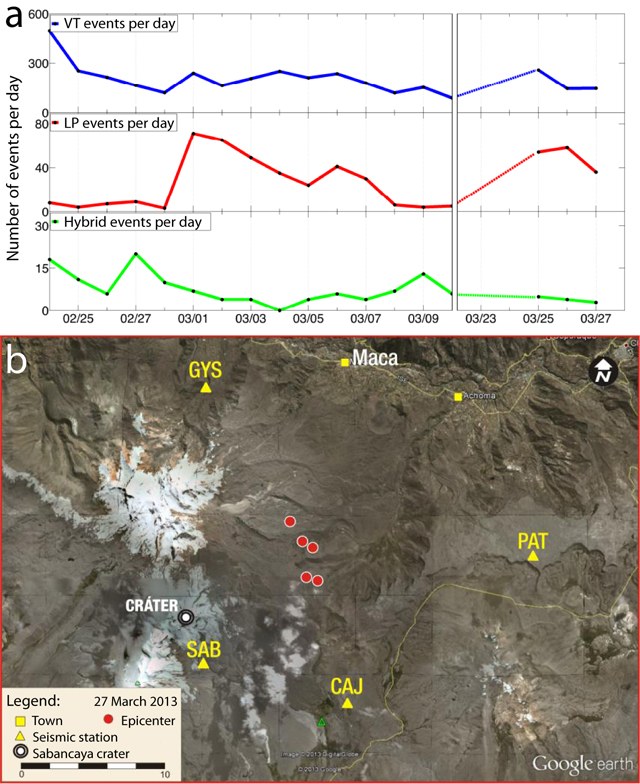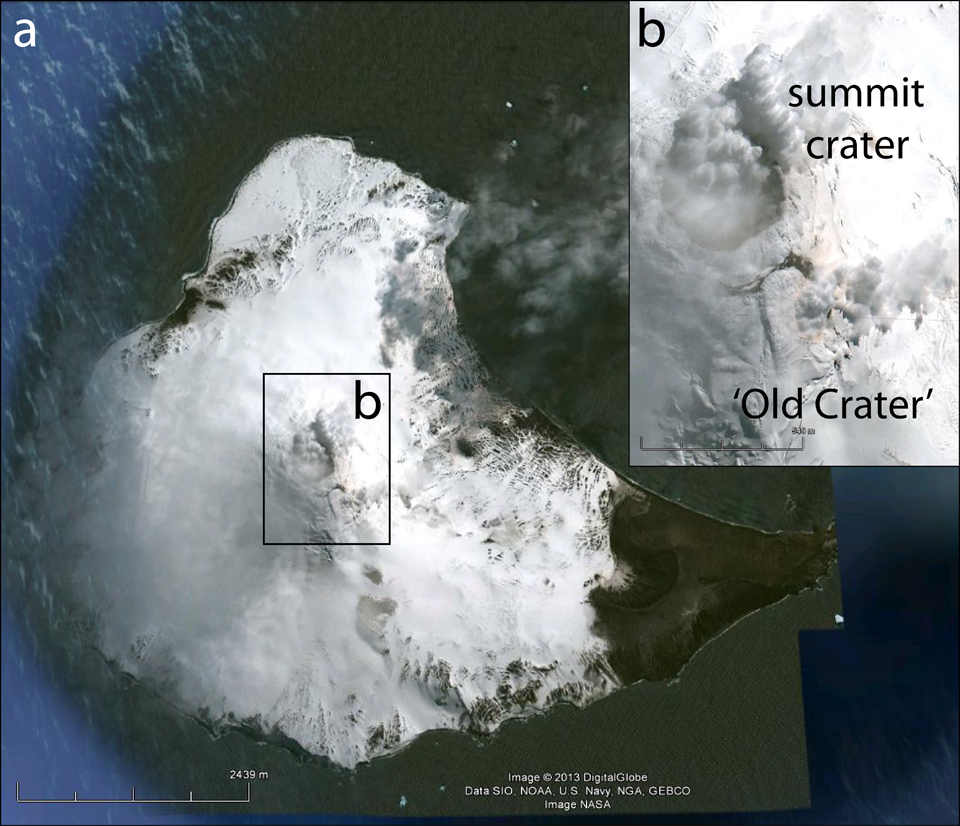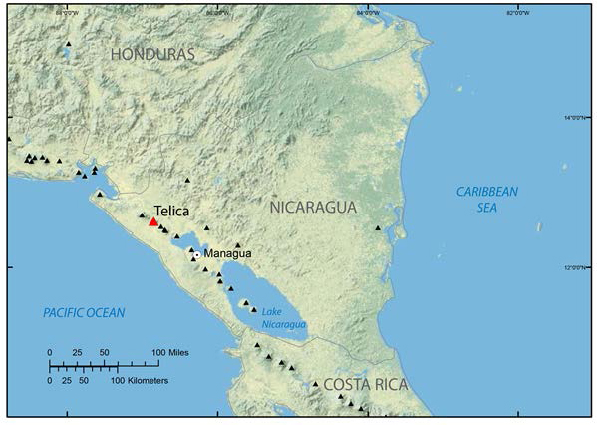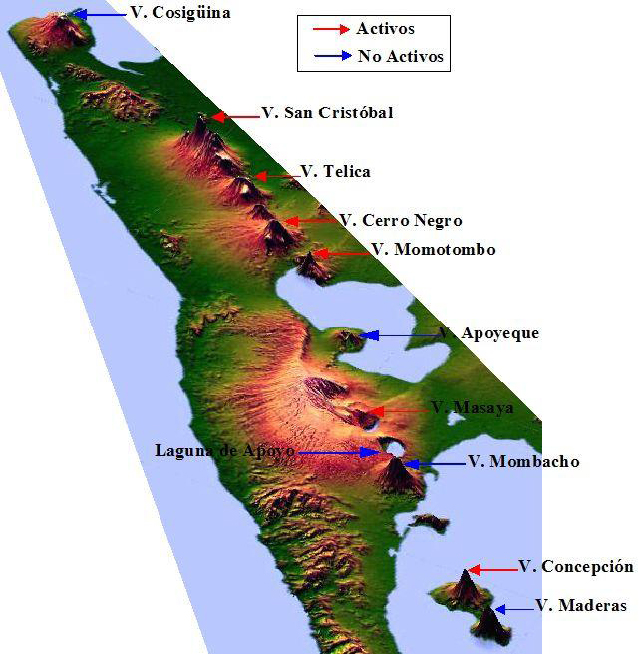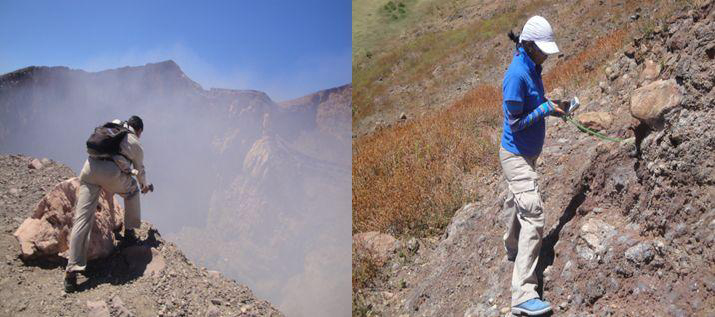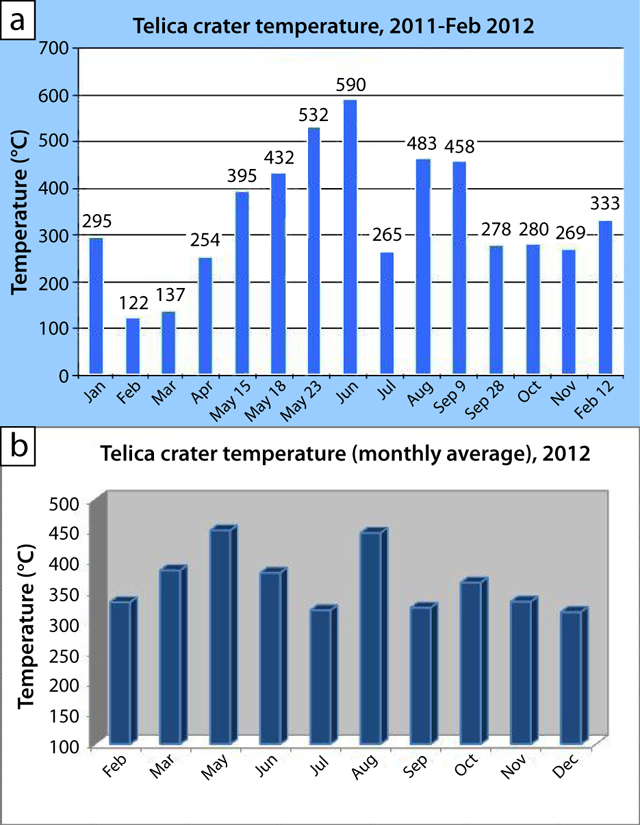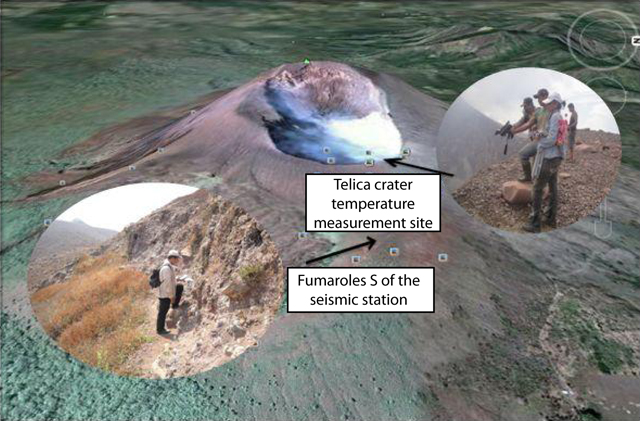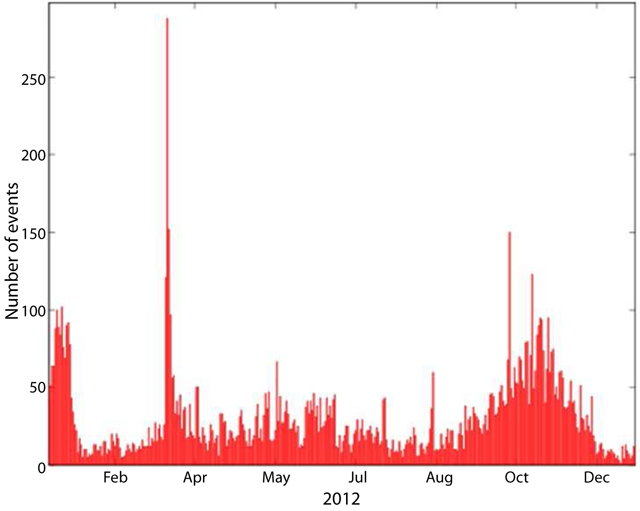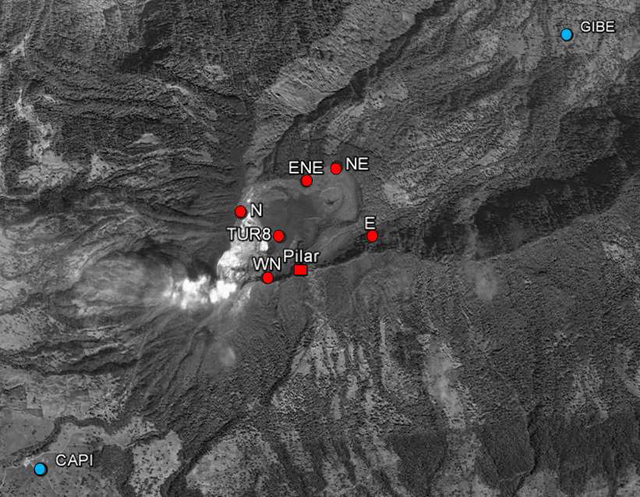Recently Published Bulletin Reports
Erebus (Antarctica) Lava lake remains active; most thermal alerts recorded since 2019
Rincon de la Vieja (Costa Rica) Frequent phreatic explosions during July-December 2023
Bezymianny (Russia) Explosion on 18 October 2023 sends ash plume 8 km high; lava flows and incandescent avalanches
Kilauea (United States) Low-level lava effusions in the lava lake at Halema’uma’u during July-December 2022
Nyamulagira (DR Congo) Lava flows and thermal activity during May-October 2023
Bagana (Papua New Guinea) Explosions, ash plumes, ashfall, and lava flows during April-September 2023
Mayon (Philippines) Lava flows, pyroclastic flows, ash emissions, and seismicity during April-September 2023
Nishinoshima (Japan) Eruption plumes and gas-and-steam plumes during May-August 2023
Krakatau (Indonesia) White gas-and-steam plumes and occasional ash plumes during May-August 2023
Merapi (Indonesia) Frequent incandescent avalanches during April-September 2023
Villarrica (Chile) Strombolian activity, gas-and-ash emissions, and crater incandescence during April-September 2023
Ebeko (Russia) Moderate explosive activity with ash plumes continued during June-November 2023
Erebus (Antarctica) — January 2024  Cite this Report
Cite this Report
Erebus
Antarctica
77.53°S, 167.17°E; summit elev. 3794 m
All times are local (unless otherwise noted)
Lava lake remains active; most thermal alerts recorded since 2019
The lava lake in the summit crater of Erebus has been active since at least 1972. Located in Antarctica overlooking the McMurdo Station on Ross Island, it is the southernmost active volcano on the planet. Because of the remote location, activity is primarily monitored by satellites. This report covers activity during 2023.
The number of thermal alerts recorded by the Hawai'i Institute of Geophysics and Planetology’s MODVOLC Thermal Alerts System increased considerably in 2023 compared to the years 2020-2022 (table 9). In contrast to previous years, the MODIS instruments aboard the Aqua and Terra satellites captured data from Erebus every month during 2023. Consistent with previous years, the lowest number of anomalous pixels were recorded in January, November, and December.
Table 9. Number of monthly MODIS-MODVOLC thermal alert pixels recorded at Erebus during 2017-2023. See BGVN 42:06 for data from 2000 through 2016. The table was compiled using data provided by the HIGP – MODVOLC Thermal Alerts System.
| Year |
Jan |
Feb |
Mar |
Apr |
May |
Jun |
Jul |
Aug |
Sep |
Oct |
Nov |
Dec |
SUM |
| 2017 |
0 |
21 |
9 |
0 |
0 |
1 |
11 |
61 |
76 |
52 |
0 |
3 |
234 |
| 2018 |
0 |
21 |
58 |
182 |
55 |
17 |
137 |
172 |
103 |
29 |
0 |
0 |
774 |
| 2019 |
2 |
21 |
162 |
151 |
55 |
56 |
75 |
53 |
29 |
19 |
1 |
0 |
624 |
| 2020 |
0 |
2 |
16 |
18 |
4 |
4 |
1 |
3 |
18 |
3 |
1 |
6 |
76 |
| 2021 |
0 |
9 |
1 |
0 |
2 |
56 |
46 |
47 |
35 |
52 |
5 |
3 |
256 |
| 2022 |
1 |
13 |
55 |
22 |
15 |
32 |
39 |
19 |
31 |
11 |
0 |
0 |
238 |
| 2023 |
2 |
33 |
49 |
82 |
41 |
32 |
70 |
64 |
42 |
17 |
5 |
11 |
448 |
Sentinel-2 infrared images showed one or two prominent heat sources within the summit crater, accompanied by adjacent smaller sources, similar to recent years (see BGVN 46:01, 47:02, and 48:01). A unique image was obtained on 25 November 2023 by the OLI-2 (Operational Land Imager-2) on Landsat 9, showing the upper part of the volcano surrounded by clouds (figure 32).
Geologic Background. Mount Erebus, the world's southernmost historically active volcano, overlooks the McMurdo research station on Ross Island. It is the largest of three major volcanoes forming the crudely triangular Ross Island. The summit of the dominantly phonolitic volcano has been modified by one or two generations of caldera formation. A summit plateau at about 3,200 m elevation marks the rim of the youngest caldera, which formed during the late-Pleistocene and within which the modern cone was constructed. An elliptical 500 x 600 m wide, 110-m-deep crater truncates the summit and contains an active lava lake within a 250-m-wide, 100-m-deep inner crater; other lava lakes are sometimes present. The glacier-covered volcano was erupting when first sighted by Captain James Ross in 1841. Continuous lava-lake activity with minor explosions, punctuated by occasional larger Strombolian explosions that eject bombs onto the crater rim, has been documented since 1972, but has probably been occurring for much of the volcano's recent history.
Information Contacts: Hawai'i Institute of Geophysics and Planetology (HIGP) - MODVOLC Thermal Alerts System, School of Ocean and Earth Science and Technology (SOEST), Univ. of Hawai'i, 2525 Correa Road, Honolulu, HI 96822, USA (URL: http://modis.higp.hawaii.edu/); Copernicus Browser, Copernicus Data Space Ecosystem, European Space Agency (URL: https://dataspace.copernicus.eu/browser/); NASA Earth Observatory, EOS Project Science Office, NASA Goddard Space Flight Center, Goddard, Maryland, USA (URL: https://earthobservatory.nasa.gov/images/152134/erebus-breaks-through).
Rincon de la Vieja (Costa Rica) — January 2024  Cite this Report
Cite this Report
Rincon de la Vieja
Costa Rica
10.83°N, 85.324°W; summit elev. 1916 m
All times are local (unless otherwise noted)
Frequent phreatic explosions during July-December 2023
Rincón de la Vieja is a volcanic complex in Costa Rica with a hot convecting acid lake that exhibits frequent weak phreatic explosions, gas-and-steam emissions, and occasional elevated sulfur dioxide levels (BGVN 45:10, 46:03, 46:11). The current eruption period began June 2021. This report covers activity during July-December 2023 and is based on weekly bulletins and occasional daily reports from the Observatorio Vulcanologico Sismologica de Costa Rica-Universidad Nacional (OVSICORI-UNA).
Numerous weak phreatic explosions continued during July-December 2023, along with gas-and-steam emissions and plumes that rose as high as 3 km above the crater rim. Many weekly OVSICORI-UNA bulletins included the previous week's number of explosions and emissions (table 9). For many explosions, the time of explosion was given (table 10). Frequent seismic activity (long-period earthquakes, volcano-tectonic earthquakes, and tremor) accompanied the phreatic activity.
Table 9. Number of reported weekly phreatic explosions and gas-and-steam emissions at Rincón de la Vieja, July-December 2023. Counts are reported for the week before the Weekly Bulletin date; not all reports included these data. Courtesy of OVSICORI-UNA.
| OVSICORI Weekly Bulletin |
Number of explosions |
Number of emissions |
| 28 Jul 2023 |
6 |
14 |
| 4 Aug 2023 |
10 |
12 |
| 1 Sep 2023 |
13 |
11 |
| 22 Sep 2023 |
12 |
13 |
| 29 Sep 2023 |
6 |
11 |
| 6 Oct 2023 |
12 |
5 |
| 13 Oct 2023 |
7 |
9 |
| 20 Oct 2023 |
1 |
15 |
| 27 Oct 2023 |
3 |
23 |
| 3 Nov 2023 |
3 |
10 |
| 17 Nov 2023 |
0 |
Some |
| 24 Nov 2023 |
0 |
14 |
| 8 Dec 2023 |
4 |
16 |
| 22 Dec 2023 |
8 |
18 |
Table 10. Summary of activity at Rincón de la Vieja during July-December 2023. Weak phreatic explosions and gas emissions are noted where the time of explosion was indicated in the weekly or daily bulletins. Height of plumes or emissions are distance above the crater rim. Courtesy of OVSICORI-UNA.
| Date |
Time |
Description of Activity |
| 1 Jul 2023 |
0156 |
Explosion. |
| 2 Jul 2023 |
0305 |
Explosion. |
| 4 Jul 2023 |
0229, 0635 |
Event at 0635 produced a gas-and-steam plume that rose 700 m and drifted W; seen by residents in Liberia (21 km SW). |
| 9 Jul 2023 |
1843 |
Explosion. |
| 21 Jul 2023 |
0705 |
Explosion. |
| 26 Jul 2023 |
1807 |
Explosion. |
| 28 Jul 2023 |
0802 |
Explosion generated a gas-and-steam plume that rose 500 m. |
| 30 Jul 2023 |
1250 |
Explosion. |
| 31 Jul 2023 |
2136 |
Explosion. |
| 11 Aug 2023 |
0828 |
Explosion. |
| 18 Aug 2023 |
1304 |
Explosion. |
| 21 Aug 2023 |
1224 |
Explosion generated gas-and-steam plumes rose 500-600 m. |
| 22 Aug 2023 |
0749 |
Explosion generated gas-and-steam plumes rose 500-600 m. |
| 24 Aug 2023 |
1900 |
Explosion. |
| 25 Aug 2023 |
0828 |
Event produced a steam-and-gas plume that rose 3 km and drifted NW. |
| 27-28 Aug 2023 |
0813 |
Four small events; the event at 0813 on 28 August lasted two minutes and generated a steam-and-gas plume that rose 2.5 km. |
| 1 Sep 2023 |
1526 |
Explosion generated plume that rose 2 km and ejected material onto the flanks. |
| 2-3 Sep 2023 |
- |
Small explosions detected in infrasound data. |
| 4 Sep 2023 |
1251 |
Gas-and-steam plume rose 1 km and drifted W. |
| 7 Nov 2023 |
1113 |
Explosion. |
| 8 Nov 2023 |
0722 |
Explosion. |
| 12 Nov 2023 |
0136 |
Small gas emissions. |
| 14 Nov 2023 |
0415 |
Small gas emissions. |
According to OVSICORI-UNA, during July-October the average weekly sulfur dioxide (SO2) flux ranged from 68 to 240 tonnes/day. However, in mid-November the flux increased to as high as 334 tonnes/day, the highest value measured in recent years. The high SO2 flux in mid-November was also detected by the TROPOMI instrument on the Sentinel-5P satellite (figure 43).
Geologic Background. Rincón de la Vieja, the largest volcano in NW Costa Rica, is a remote volcanic complex in the Guanacaste Range. The volcano consists of an elongated, arcuate NW-SE-trending ridge constructed within the 15-km-wide early Pleistocene Guachipelín caldera, whose rim is exposed on the south side. Sometimes known as the "Colossus of Guanacaste," it has an estimated volume of 130 km3 and contains at least nine major eruptive centers. Activity has migrated to the SE, where the youngest-looking craters are located. The twin cone of Santa María volcano, the highest peak of the complex, is located at the eastern end of a smaller, 5-km-wide caldera and has a 500-m-wide crater. A Plinian eruption producing the 0.25 km3 Río Blanca tephra about 3,500 years ago was the last major magmatic eruption. All subsequent eruptions, including numerous historical eruptions possibly dating back to the 16th century, have been from the prominent active crater containing a 500-m-wide acid lake located ENE of Von Seebach crater.
Information Contacts: Observatorio Vulcanológico Sismológica de Costa Rica-Universidad Nacional (OVSICORI-UNA), Apartado 86-3000, Heredia, Costa Rica (URL: http://www.ovsicori.una.ac.cr/); NASA Global Sulfur Dioxide Monitoring Page, Atmospheric Chemistry and Dynamics Laboratory, NASA Goddard Space Flight Center (NASA/GSFC), 8800 Greenbelt Road, Goddard MD 20771, USA (URL: https://so2.gsfc.nasa.gov/).
Bezymianny (Russia) — November 2023  Cite this Report
Cite this Report
Bezymianny
Russia
55.972°N, 160.595°E; summit elev. 2882 m
All times are local (unless otherwise noted)
Explosion on 18 October 2023 sends ash plume 8 km high; lava flows and incandescent avalanches
Bezymianny, located on Russia’s Kamchatka Peninsula, has had eruptions since 1955 characterized by dome growth, explosions, pyroclastic flows, ash plumes, and ashfall. Activity during November 2022-April 2023 included gas-and-steam emissions, lava dome collapses generating avalanches, and persistent thermal activity. Similar eruptive activity continued from May through October 2023, described here based on information from weekly and daily reports of the Kamchatka Volcano Eruptions Response Team (KVERT), notices from Tokyo VAAC (Volcanic Ash Advisory Center), and from satellite data.
Overall activity decreased after the strong period of activity in late March through April 2023, which included ash explosions during 29 March and 7-8 April 2023 that sent plumes as high as 10-12 km altitude, along with dome growth and lava flows (BGVN 48:05). This reduced activity can be seen in the MIROVA thermal detection system graph (figure 56), which was consistent with data from the MODVOLC thermal detection system and with Sentinel-2 satellite images that showed persistent hotspots in the summit crater when conditions allowed observations. A renewed period of strong activity began in mid-October 2023.
Activity increased significantly on 17 October 2023 when large collapses began during 0700-0830 on the E flanks of the lava dome and continued to after 0930 the next day (figure 57). Ash plumes rose to an altitude of 4.5-5 km, extending 220 km NNE by 18 October. A large explosion at 1630 on 18 October produced an ash plume that rose to an altitude of 11 km (8 km above the summit) and drifted NNE and then NW, extending 900 km NW within two days at an altitude of 8 km. Minor ashfall was noted in Kozyrevsk (45 km WNW). At 0820 on 20 October an ash plume was identified in satellite images drifting 100 km ENE at altitudes of 4-4.5 km.
Lava flows and hot avalanches from the dome down the SE flank continued over the next few days, including 23 October when clear conditions allowed good observations (figures 58 and 59). A large thermal anomaly was observed over the volcano through 24 October, and in the summit crater on 30 October (figure 60). Strong fumarolic activity continued, with numerous avalanches and occasional incandescence. By the last week of October, volcanic activity had decreased to a level consistent with that earlier in the reporting period.
Aviation warnings were frequently updated during 17-20 October. KVERT issued a Volcano Observatory Notice for Aviation (VONA) on 17 October at 1419 and 1727 (0219 and 0527 UTC) raising the Aviation Color Code (ACC) from Yellow to Orange (second highest level). The next day, KVERT issued a VONA at 1705 (0505 UTC) raising the ACC to Red (highest level) but lowered it back to Orange at 2117 (0917 UTC). After another decrease to Yellow and back to Orange, the ACC was reduced to Yellow on 20 October at 1204 (0004 UTC). In addition, the Tokyo VAAC issued a series of Volcanic Ash Advisories beginning on 16 October and continuing through 30 October.
Geologic Background. The modern Bezymianny, much smaller than its massive neighbors Kamen and Kliuchevskoi on the Kamchatka Peninsula, was formed about 4,700 years ago over a late-Pleistocene lava-dome complex and an edifice built about 11,000-7,000 years ago. Three periods of intensified activity have occurred during the past 3,000 years. The latest period, which was preceded by a 1,000-year quiescence, began with the dramatic 1955-56 eruption. This eruption, similar to that of St. Helens in 1980, produced a large open crater that was formed by collapse of the summit and an associated lateral blast. Subsequent episodic but ongoing lava-dome growth, accompanied by intermittent explosive activity and pyroclastic flows, has largely filled the 1956 crater.
Information Contacts: Kamchatka Volcanic Eruptions Response Team (KVERT), Far Eastern Branch, Russian Academy of Sciences, 9 Piip Blvd., Petropavlovsk-Kamchatsky, 683006, Russia (URL: http://www.kscnet.ru/ivs/kvert/); Kamchatka Volcanological Station, Kamchatka Branch of Geophysical Survey, (KB GS RAS), Klyuchi, Kamchatka Krai, Russia (URL: http://volkstat.ru/); Tokyo Volcanic Ash Advisory Center (VAAC), 1-3-4 Otemachi, Chiyoda-ku, Tokyo 100-8122, Japan (URL: http://ds.data.jma.go.jp/svd/vaac/data/); Hawai'i Institute of Geophysics and Planetology (HIGP) - MODVOLC Thermal Alerts System, School of Ocean and Earth Science and Technology (SOEST), Univ. of Hawai'i, 2525 Correa Road, Honolulu, HI 96822, USA (URL: http://modis.higp.hawaii.edu/); MIROVA (Middle InfraRed Observation of Volcanic Activity), a collaborative project between the Universities of Turin and Florence (Italy) supported by the Centre for Volcanic Risk of the Italian Civil Protection Department (URL: http://www.mirovaweb.it/); Copernicus Browser, Copernicus Data Space Ecosystem, European Space Agency (URL: https://dataspace.copernicus.eu/browser/).chr
Kilauea (United States) — January 2023  Cite this Report
Cite this Report
Kilauea
United States
19.421°N, 155.287°W; summit elev. 1222 m
All times are local (unless otherwise noted)
Low-level lava effusions in the lava lake at Halema’uma’u during July-December 2022
Kīlauea is the southeastern-most volcano in Hawaii and overlaps the E flank of the Mauna Loa volcano. Its East Rift Zone (ERZ) has been intermittently active for at least 2,000 years. An extended eruption period began in January 1983 and was characterized by open lava lakes and lava flows from the summit caldera and the East Rift Zone. During May 2018 magma migrated into the Lower East Rift Zone (LERZ) and opened 24 fissures along a 6-km-long NE-trending fracture zone that produced lava flows traveling in multiple directions. As lava emerged from the fissures, the lava lake at Halema'uma'u drained and explosions sent ash plumes to several kilometers altitude (BGVN 43:10).
The current eruption period started during September 2021 and has recently been characterized by lava effusions, spatter, and sulfur dioxide emissions in the active Halema’uma’u lava lake (BGVN 47:08). Lava effusions, some spatter, and sulfur dioxide emissions have continued during this reporting period of July through December 2022 using daily reports, volcanic activity notices, and abundant photo, map, and video data from the US Geological Survey's (USGS) Hawaiian Volcano Observatory (HVO).
Summary of activity during July-December 2022. Low-level effusions have continued at the western vent of the Halema’uma’u crater during July through early December 2022. Occasional weak ooze-outs (also called lava break outs) would occur along the margins of the crater floor. The overall level of the active lava lake throughout the reporting period gradually increased due to infilling, however it stagnated in mid-September (table 13). During September through November, activity began to decline, though lava effusions persisted at the western vent. By 9 December, the active part of the lava lake had completely crusted over, and incandescence was no longer visible.
Table 13. Summary of measurements taken during overflights at Kīlauea that show a gradual increase in the active lava lake level and the volume of lava effused since 29 September 2021. Lower activity was reported during September-October. Data collected during July-December 2022. Courtesy of HVO.
| Date: |
Level of the active lava lake (m): |
Cumulative volume of lava effused (million cubic meters): |
| 7 Jul 2022 |
130 |
95 |
| 19 Jul 2022 |
133 |
98 |
| 4 Aug 2022 |
136 |
102 |
| 16 Aug 2022 |
137 |
104 |
| 12 Sep 2022 |
143 |
111 |
| 5 Oct 2022 |
143 |
111 |
| 28 Oct 2022 |
143 |
111 |
Activity during July 2022. Lava effusions were reported from the western vent in the Halema’uma’u crater, along with occasional weak ooze-outs along the margins of the crater floor. The height of the lava lake was variable due to deflation-inflation tilt events; for example, the lake level dropped approximately 3-4 m during a summit deflation-inflation event reported on 1 July. Webcam images taken during the night of 6-12 July showed intermittent low-level spattering at the western vent that rose less than 10 m above the vent (figure 519). Measurements made during an overflight on 7 July indicated that the crater floor was infilled about 130 m and that 95 million cubic meters of lava had been effused since 29 September 2021. A single, relatively small lava ooze-out was active to the S of the lava lake. Around midnight on 8 July there were two brief periods of lava overflow onto the lake margins. On 9 July lava ooze-outs were reported near the SE and NE edges of the crater floor and during 10-11 July they occurred near the E, NE, and NW edges. On 16 July crater incandescence was reported, though the ooze-outs and spattering were not visible. On 18 July overnight webcam images showed incandescence in the western vent complex and two ooze-outs were reported around 0000 and 0200 on 19 July. By 0900 there were active ooze-outs along the SW edge of the crater floor. Measurements made from an overflight on 19 July indicated that the crater floor was infilled about 133 m and 98 million cubic meters of lava had erupted since 29 September 2021 (figure 520). On 20 July around 1600 active ooze-outs were visible along the N edge of the crater, which continued through the next day. Extensive ooze-outs occurred along the W margin during 24 July until 1900; on 26 July minor ooze-outs were noted along the N margin. Minor spattering was visible on 29 July along the E margin of the lake. The sulfur dioxide emission rates ranged 650-2,800 tons per day (t/d), the higher of which was measured on 8 July (figure 519).
Activity during August 2022. The eruption continued in the Halema’uma’u crater at the western vent. According to HVO the lava in the active lake remained at the level of the bounding levees. Occasional minor ooze-outs were observed along the margins of the crater floor. Strong nighttime crater incandescence was visible after midnight on 6 August over the western vent cone. During 6-7 August scattered small lava lobes were active along the crater floor and incandescence persisted above the western vent through 9 August. During 7-9 August HVO reported a single lava effusion source was active along the NW margin of the crater floor. Measurements from an overflight on 4 August indicated that the crater floor was infilled about 136 m total and that 102 million cubic meters of lava had been erupted since the start of the eruption. Lava breakouts were reported along the N, NE, E, S, and W margins of the crater during 10-16 August. Another overflight survey conducted on 16 August indicated that the crater floor infilled about 137 m and 104 million cubic meters of lava had been erupted since September 2021. Measured sulfur dioxide emissions rates ranged 1,150-2,450 t/d, the higher of which occurred on 8 August.
Activity during September 2022. During September, lava effusion continued from the western vent into the active lava lake and onto the crater floor. Intermittent minor ooze-outs were reported through the month. A small ooze-out was visible on the W crater floor margin at 0220 on 2 September, which showed decreasing surface activity throughout the day, but remained active through 3 September. On 3 September around 1900 a lava outbreak occurred along the NW margin of the crater floor but had stopped by the evening of 4 September. Field crews monitoring the summit lava lake on 9 September observed spattering on the NE margin of the lake that rose no higher than 10 m, before falling back onto the lava lake crust (figure 521). Overflight measurements on 12 September indicated that the crater floor was infilled a total of 143 m and 111 million cubic meters of lava had been erupted since September 2021. Extensive breakouts in the W and N part of the crater floor were reported at 1600 on 20 September and continued into 26 September. The active part of the lava lake dropped by 10 m while other parts of the crater floor dropped by several meters. Summit tiltmeters recorded a summit seismic swarm of more than 80 earthquakes during 1500-1800 on 21 September, which occurred about 1.5 km below Halema’uma’u; a majority of these were less than Mw 2. By 22 September the active part of the lava lake was infilled about 2 m. On 23 September the western vent areas exhibited several small spatter cones with incandescent openings, along with weak, sporadic spattering (figure 522). The sulfur dioxide emission rate ranged from 930 t/d to 2,000 t/d, the higher of which was measured on 6 September.
Activity during October 2022. Activity during October declined slightly compared to previous months, though lava effusions persisted from the western vent into the active lava lake and onto the crater floor during October (figure 523). Slight variations in the lava lake were noted throughout the month. HVO reported that around 0600 on 3 October the level of the lava lake has lowered slightly. Overflight measurements taken on 5 October indicated that the crater floor was infilled a total of about 143 m and that 111 million cubic meters of lava had been effused since September 2021. During 6-7 October the lake gradually rose 0.5 m. Sulfur dioxide measurements made on 22 October had an emission rate of 700 t/d. Another overflight taken on 28 October showed that there was little to no change in the elevation of the crater floor: the crater floor was infilled a total of 143 m and 111 million cubic meters of lava had erupted since the start of the eruption.
Activity during November 2022. Activity remained low during November, though HVO reported that lava from the western vent continued to effuse into the active lava lake and onto the crater floor throughout the month. The rate of sulfur dioxide emissions during November ranged from 300-600 t/d, the higher amount of which occurred on 9 November.
Activity during December 2022. Similar low activity was reported during December, with lava effusing from the western vent into the active lava lake and onto the crater floor. During 4-5 December the active part of the lava lake was slightly variable in elevation and fluctuated within 1 m. On 9 December HVO reported that lava was no longer erupting from the western vent in the Halema’uma’u crater and that sulfur dioxide emissions had returned to near pre-eruption background levels; during 10-11 December, the lava lake had completely crusted over, and no incandescence was visible (figure 524). Time lapse camera images covering the 4-10 December showed that the crater floor showed weak deflation and no inflation. Some passive events of crustal overturning were reported during 14-15 December, which brought fresh incandescent lava to the lake surface. The sulfur dioxide emission rate was approximately 200 t/d on 14 December. A smaller overturn event on 17 December and another that occurred around 0000 and into the morning of 20 December were also detected. A small seismic swarm was later detected on 30 December.
Geologic Background. Kilauea overlaps the E flank of the massive Mauna Loa shield volcano in the island of Hawaii. Eruptions are prominent in Polynesian legends; written documentation since 1820 records frequent summit and flank lava flow eruptions interspersed with periods of long-term lava lake activity at Halemaumau crater in the summit caldera until 1924. The 3 x 5 km caldera was formed in several stages about 1,500 years ago and during the 18th century; eruptions have also originated from the lengthy East and Southwest rift zones, which extend to the ocean in both directions. About 90% of the surface of the basaltic shield volcano is formed of lava flows less than about 1,100 years old; 70% of the surface is younger than 600 years. The long-term eruption from the East rift zone between 1983 and 2018 produced lava flows covering more than 100 km2, destroyed hundreds of houses, and added new coastline.
Information Contacts: Hawaiian Volcano Observatory (HVO), U.S. Geological Survey, PO Box 51, Hawai'i National Park, HI 96718, USA (URL: http://hvo.wr.usgs.gov/).
Nyamulagira (DR Congo) — November 2023  Cite this Report
Cite this Report
Nyamulagira
DR Congo
1.408°S, 29.2°E; summit elev. 3058 m
All times are local (unless otherwise noted)
Lava flows and thermal activity during May-October 2023
Nyamulagira (also known as Nyamuragira) is a shield volcano in the Democratic Republic of Congo with the summit truncated by a small 2 x 2.3 km caldera with walls up to about 100 m high. Documented eruptions have occurred within the summit caldera, as well as from numerous flank fissures and cinder cones. The current eruption period began in April 2018 and has more recently been characterized by summit crater lava flows and thermal activity (BGVN 48:05). This report describes lava flows and variable thermal activity during May through October 2023, based on information from the Observatoire Volcanologique de Goma (OVG) and various satellite data.
Lava lake activity continued during May. The MIROVA (Middle InfraRed Observation of Volcanic Activity) system recorded moderate-to-strong thermal activity throughout the reporting period; activity was more intense during May and October and relatively weaker from June through September (figure 95). The MODVOLC thermal algorithm, detected a total of 209 thermal alerts. There were 143 hotspots detected during May, eight during June, nine during September, and 49 during October. This activity was also reflected in infrared satellite images, where a lava flow was visible in the NW part of the crater on 7 May and strong activity was seen in the center of the crater on 4 October (figure 96). Another infrared satellite image taken on 12 May showed still active lava flows along the NW margin of the crater. According to OVG lava effusions were active during 7-29 May and moved to the N and NW parts of the crater beginning on 9 May. Strong summit crater incandescence was visible from Goma (27 km S) during the nights of 17, 19, and 20 May (figure 97). On 17 May there was an increase in eruptive activity, which peaked at 0100 on 20 May. Notable sulfur dioxide plumes drifted NW and W during 19-20 May (figure 98). Drone footage acquired in partnership with the USGS (United States Geological Survey) on 20 May captured images of narrow lava flows that traveled about 100 m down the W flank (figure 99). Data from the Rumangabo seismic station indicated a decreasing trend in activity during 17-21 May. Although weather clouds prevented clear views of the summit, a strong thermal signature on the NW flank was visible in an infrared satellite image on 22 May, based on an infrared satellite image. On 28 May the lava flows on the upper W flank began to cool and solidify. By 29 May seismicity returned to levels similar to those recorded before the 17 May increase. Lava effusion continued but was confined to the summit crater; periodic crater incandescence was observed.
Low-level activity was noted during June through October. On 1 June OVG reported that seismicity remained at lower levels and that crater incandescence had been absent for three days, though infrared satellite imagery showed continued lava effusion in the summit crater. The lava flows on the flanks covered an estimated 0.6 km2. Satellite imagery continued to show thermal activity confined to the lava lake through October (figure 96), although no lava flows or significant sulfur dioxide emissions were reported.
Geologic Background. Africa's most active volcano, Nyamulagira (also known as Nyamuragira), is a massive high-potassium basaltic shield about 25 km N of Lake Kivu and 13 km NNW of the steep-sided Nyiragongo volcano. The summit is truncated by a small 2 x 2.3 km caldera that has walls up to about 100 m high. Documented eruptions have occurred within the summit caldera, as well as from the numerous flank fissures and cinder cones. A lava lake in the summit crater, active since at least 1921, drained in 1938, at the time of a major flank eruption. Recent lava flows extend down the flanks more than 30 km from the summit as far as Lake Kivu; extensive lava flows from this volcano have covered 1,500 km2 of the western branch of the East African Rift.
Information Contacts: Observatoire Volcanologique de Goma (OVG), Departement de Geophysique, Centre de Recherche en Sciences Naturelles, Lwiro, D.S. Bukavu, DR Congo; Hawai'i Institute of Geophysics and Planetology (HIGP) - MODVOLC Thermal Alerts System, School of Ocean and Earth Science and Technology (SOEST), Univ. of Hawai'i, 2525 Correa Road, Honolulu, HI 96822, USA (URL: http://modis.higp.hawaii.edu/); MIROVA (Middle InfraRed Observation of Volcanic Activity), a collaborative project between the Universities of Turin and Florence (Italy) supported by the Centre for Volcanic Risk of the Italian Civil Protection Department (URL: http://www.mirovaweb.it/); NASA Global Sulfur Dioxide Monitoring Page, Atmospheric Chemistry and Dynamics Laboratory, NASA Goddard Space Flight Center (NASA/GSFC), 8800 Greenbelt Road, Goddard, Maryland, USA (URL: https://so2.gsfc.nasa.gov/); Copernicus Browser, Copernicus Data Space Ecosystem, European Space Agency (URL: https://dataspace.copernicus.eu/browser/); Charles Balagizi, Goma Volcano Observatory, Departement de Geophysique, Centre de Recherche en Sciences Naturelles, Lwiro, D.S. Bukavu, DR Congo.
Bagana (Papua New Guinea) — October 2023  Cite this Report
Cite this Report
Bagana
Papua New Guinea
6.137°S, 155.196°E; summit elev. 1855 m
All times are local (unless otherwise noted)
Explosions, ash plumes, ashfall, and lava flows during April-September 2023
The remote volcano of Bagana is located in central Bougainville Island, Papua New Guinea. Recorded eruptions date back to 1842 and activity has consisted of effusive activity that has built a small lava dome in the summit crater and occasional explosions that produced pyroclastic flows. The most recent eruption has been ongoing since February 2000 and has produced occasional explosions, ash plumes, and lava flows. More recently, activity has been characterized by ongoing effusive activity and ash emissions (BGVN 48:04). This report updates activity from April through September 2023 that has consisted of explosions, ash plumes, ashfall, and lava flows, using information from the Darwin Volcanic Ash Advisory Center (VAAC) and satellite data.
An explosive eruption was reported on 7 July that generated a large gas-and-ash plume to high altitudes and caused significant ashfall in local communities; the eruption plume had reached upper tropospheric (16-18 km altitude) altitudes by 2200, according to satellite images. Sulfur dioxide plumes were detected in satellite images on 8 July and indicated that the plume was likely a mixture of gas, ice, and ash. A report issued by the Autonomous Bougainville Government (ABG) (Torokina District, Education Section) on 10 July noted that significant ash began falling during 2000-2100 on 7 July and covered most areas in the Vuakovi, Gotana (9 km SW), Koromaketo, Laruma (25 km W) and Atsilima (27 km NW) villages. Pyroclastic flows also occurred, according to ground-based reports; small deposits confined to one drainage were inspected by RVO during an overflight on 17 July and were confirmed to be from the 7 July event. Ashfall continued until 10 July and covered vegetation, which destroyed bushes and gardens and contaminated rivers and streams.
RVO reported another eruption on 14 July. The Darwin VAAC stated that an explosive event started around 0830 on 15 July and produced an ash plume that rose to 16.5 km altitude by 1000 and drifted N, according to satellite images. The plume continued to drift N and remained visible through 1900, and by 2150 it had dissipated.
Ashfall likely from both the 7 and 15 July events impacted about 8,111 people in Torokina (20 km SW), including Tsito/Vuakovi, Gotana, Koromaketo, Kenaia, Longkogari, Kenbaki, Piva (13 km SW), and Atsinima, and in the Tsitovi district, according to ABG. Significant ashfall was also reported in Ruruvu (22 km N) in the Wakunai District of Central Bougainville, though the thickness of these deposits could not be confirmed. An evacuation was called for the villages in Wakunai, where heavy ashfall had contaminated water sources; the communities of Ruruvu, Togarau, Kakarapaia, Karauturi, Atao, and Kuritaturi were asked to evacuate to a disaster center at the Wakunai District Station, and communities in Torokina were asked to evacuate to the Piva District station. According to a news article, more than 7,000 people needed temporary accommodations, with about 1,000 people in evacuation shelters. Ashfall had deposited over a broad area, contaminating water supplies, affecting crops, and collapsing some roofs and houses in rural areas. Schools were temporarily shut down. Intermittent ash emissions continued through the end of July and drifted NNW, NW, and SW. Fine ashfall was reported on the coast of Torokina, and ash plumes also drifted toward Laruma and Atsilima.
A small explosive eruption occurred at 2130 on 28 July that ejected material from the crater vents, according to reports from Torokina, in addition to a lava flow that contained two lobes. A second explosion was detected at 2157. Incandescence from the lava flow was visible from Piva as it descended the W flank around 2000 on 29 July (figure 47). The Darwin VAAC reported that a strong thermal anomaly was visible in satellite images during 30-31 July and that ash emissions rose to 2.4 km altitude and drifted WSW on 30 July. A ground report from RVO described localized emissions at 0900 on 31 July.
The Darwin VAAC reported that ash plumes were identified in satellite imagery at 0800 and 1220 on 12 August and rose to 2.1 km and 3 km altitude and drifted NW and W, respectively. A news report stated that aid was sent to more than 6,300 people that were adversely affected by the eruption. Photos taken during 17-19 August showed ash emissions rising no higher than 1 km above the summit and drifting SE. A small explosion generated an ash plume during the morning of 19 August. Deposits from small pyroclastic flows were also captured in the photos. Satellite images captured lava flows and pyroclastic flow deposits. Two temporary seismic stations were installed near Bagana on 17 August at distances of 7 km WSW (Vakovi station) and 11 km SW (Kepox station). The Kepox station immediately started to record continuous, low-frequency background seismicity.
Satellite data. Little to no thermal activity was detected during April through mid-July 2023; only one anomaly was recorded during early April and one during early June, according to MIROVA (Middle InfraRed Observation of Volcanic Activity) data (figure 48). Thermal activity increased in both power and frequency during mid-July through September, although there were still some short gaps in detected activity. MODVOLC also detected increased thermal activity during August; thermal hotspots were detected a total of five times on 19, 20, and 27 August. Weak thermal anomalies were also captured in infrared satellite images on clear weather days throughout the reporting period on 7, 12, and 17 April, 27 May, 1, 6, 16, and 31 July, and 19 September (figure 48); a strong thermal anomaly was visible on 31 July. Distinct sulfur dioxide plumes that drifted generally NW were intermittently captured by the TROPOMI instrument on the Sentinel-5P satellite and sometimes exceeded two Dobson Units (DUs) (figure 49).
Geologic Background. Bagana volcano, in a remote portion of central Bougainville Island, is frequently active. This massive symmetrical cone was largely constructed by an accumulation of viscous andesitic lava flows. The entire edifice could have been constructed in about 300 years at its present rate of lava production. Eruptive activity is characterized by non-explosive effusion of viscous lava that maintains a small lava dome in the summit crater, although occasional explosive activity produces pyroclastic flows. Lava flows with tongue-shaped lobes up to 50 m thick and prominent levees descend the flanks on all sides.
Information Contacts: Rabaul Volcano Observatory (RVO), Geohazards Management Division, Department of Mineral Policy and Geohazards Management (DMPGM), PO Box 3386, Kokopo, East New Britain Province, Papua New Guinea; Darwin Volcanic Ash Advisory Centre (VAAC), Bureau of Meteorology, Northern Territory Regional Office, PO Box 40050, Casuarina, NT 0811, Australia (URL: http://www.bom.gov.au/info/vaac/); MIROVA (Middle InfraRed Observation of Volcanic Activity), a collaborative project between the Universities of Turin and Florence (Italy) supported by the Centre for Volcanic Risk of the Italian Civil Protection Department (URL: http://www.mirovaweb.it/); Hawai'i Institute of Geophysics and Planetology (HIGP) - MODVOLC Thermal Alerts System, School of Ocean and Earth Science and Technology (SOEST), Univ. of Hawai'i, 2525 Correa Road, Honolulu, HI 96822, USA (URL: http://modis.higp.hawaii.edu/); NASA Global Sulfur Dioxide Monitoring Page, Atmospheric Chemistry and Dynamics Laboratory, NASA Goddard Space Flight Center (NASA/GSFC), 8800 Greenbelt Road, Goddard, Maryland, USA (URL: https://so2.gsfc.nasa.gov/); Copernicus Browser, Copernicus Data Space Ecosystem, European Space Agency (URL: https://dataspace.copernicus.eu/browser/); Autonomous Bougainville Government, P.O Box 322, Buka, AROB, PNG (URL: https://abg.gov.pg/); Andrew Tupper (Twitter: @andrewcraigtupp); Simon Carn, Geological and Mining Engineering and Sciences, Michigan Technological University, 1400 Townsend Drive, Houghton, MI 49931, USA (URL: http://www.volcarno.com/, Twitter: @simoncarn); Radio NZ (URL: https://www.rnz.co.nz/news/pacific/494464/more-than-7-000-people-in-bougainville-need-temporary-accommodation-after-eruption); USAID, 1300 Pennsylvania Ave, NW, Washington DC 20004, USA (URL: https://www.usaid.gov/pacific-islands/press-releases/aug-08-2023-united-states-provides-immediate-emergency-assistance-support-communities-affected-mount-bagana-volcanic-eruptions).
Mayon (Philippines) — October 2023  Cite this Report
Cite this Report
Mayon
Philippines
13.257°N, 123.685°E; summit elev. 2462 m
All times are local (unless otherwise noted)
Lava flows, pyroclastic flows, ash emissions, and seismicity during April-September 2023
Mayon is located in the Philippines and has steep upper slopes capped by a small summit crater. Historical eruptions date back to 1616 CE that have been characterized by Strombolian eruptions, lava flows, pyroclastic flows, and mudflows. Eruptions mostly originated from a central conduit. Pyroclastic flows and mudflows have commonly descended many of the approximately 40 drainages that surround the volcano. The most recent eruption occurred during June through October 2022 and consisted of lava dome growth and gas-and-steam emissions (BGVN 47:12). A new eruption was reported during late April 2023 and has included lava flows, pyroclastic density currents, ash emissions, and seismicity. This report covers activity during April through September 2023 based on daily bulletins from the Philippine Institute of Volcanology and Seismology (PHIVOLCS).
During April through September 2023, PHIVOLCS reported near-daily rockfall events, frequent volcanic earthquakes, and sulfur dioxide measurements. Gas-and-steam emissions rose 100-900 m above the crater and drifted in different directions. Nighttime crater incandescence was often visible during clear weather and was accompanied by incandescent avalanches of material. Activity notably increased during June when lava flows were reported on the S, SE, and E flanks (figure 52). The MIROVA graph (Middle InfraRed Observation of Volcanic Activity) showed strong thermal activity coincident with these lava flows, which remained active through September (figure 53). According to the MODVOLC thermal algorithm, a total of 110 thermal alerts were detected during the reporting period: 17 during June, 40 during July, 27 during August, and 26 during September. During early June, pyroclastic density currents (PDCs) started to occur more frequently.
Low activity was reported during much of April and May; gas-and-steam emissions rose 100-900 m above the crater and generally drifted in different directions. A total of 52 rockfall events and 18 volcanic earthquakes were detected during April and 147 rockfall events and 13 volcanic events during May. Sulfur dioxide flux measurements ranged between 400-576 tons per day (t/d) during April, the latter of which was measured on 29 April and between 162-343 t/d during May, the latter of which was measured on 13 May.
Activity during June increased, characterized by lava flows, pyroclastic density currents (PDCs), crater incandescence and incandescent rockfall events, gas-and-steam emissions, and continued seismicity. Weather clouds often prevented clear views of the summit, but during clear days, moderate gas-and-steam emissions rose 100-2,500 m above the crater and drifted in multiple directions. A total of 6,237 rockfall events and 288 volcanic earthquakes were detected. The rockfall events often deposited material on the S and SE flanks within 700-1,500 m of the summit crater and ash from the events drifted SW, S, SE, NE, and E. Sulfur dioxide emissions ranged between 149-1,205 t/d, the latter of which was measured on 10 June. Short-term observations from EDM and electronic tiltmeter monitoring indicated that the upper slopes were inflating since February 2023. Longer-term ground deformation parameters based on EDM, precise leveling, continuous GPS, and electronic tilt monitoring indicated that the volcano remained inflated, especially on the NW and SE flanks. At 1000 on 5 June the Volcano Alert Level (VAL) was raised to 2 (on a 0-5 scale). PHIVOLCS noted that although low-level volcanic earthquakes, ground deformation, and volcanic gas emissions indicated unrest, the steep increase in rockfall frequency may indicate increased dome activity.
A total of 151 dome-collapse PDCs occurred during 8-9 and 11-30 June, traveled 500-2,000 m, and deposited material on the S flank within 2 km of the summit crater. During 8-9 June the VAL was raised to 3. At approximately 1947 on 11 June lava flow activity was reported; two lobes traveled within 500 m from the crater and deposited material on the S (Mi-isi), SE (Bonga), and E (Basud) flanks. Weak seismicity accompanied the lava flow and slight inflation on the upper flanks. This lava flow remained active through 30 June, moving down the S and SE flank as far as 2.5 km and 1.8 km, respectively and depositing material up to 3.3 km from the crater. During 15-16 June traces of ashfall from the PDCs were reported in Sitio Buga, Nabonton, City of Ligao and Purok, and San Francisco, Municipality of Guinobatan. During 28-29 June there were two PDCs generated by the collapse of the lava flow front, which generated a light-brown ash plume 1 km high. Satellite monitors detected significant concentrations of sulfur dioxide beginning on 29 June. On 30 June PDCs primarily affected the Basud Gully on the E flank, the largest of which occurred at 1301 and lasted eight minutes, based on the seismic record. Four PDCs generated between 1800 and 2000 that lasted approximately four minutes each traveled 3-4 km on the E flank and generated an ash plume that rose 1 km above the crater and drifted N and NW. Ashfall was recorded in Tabaco City.
Similar strong activity continued during July; slow lava effusion remained active on the S and SE flanks and traveled as far as 2.8 km and 2.8 km, respectively and material was deposited as far as 4 km from the crater. There was a total of 6,983 rockfall events and 189 PDCs that affected the S, SE, and E flanks. The volcano network detected a total of 2,124 volcanic earthquakes. Continuous gas-and-steam emissions rose 200-2,000 m above the crater and drifted in multiple directions. Sulfur dioxide emissions averaged 792-4,113 t/d, the latter of which was measured on 28 July. During 2-4 July three PDCs were generated from the collapse of the lava flow and resulting light brown plumes rose 200-300 m above the crater. Continuous tremor pulses were reported beginning at 1547 on 3 July through 7 July at 1200, at 2300 on 8 July and going through 0300 on 10 July, and at 2300 on 16 July, as recorded by the seismic network. During 6-9 July there were 10 lava flow-collapse-related PDCs that generated light brown plumes 300-500 m above the crater. During 10-11 July light ashfall was reported in some areas of Mabinit, Legazpi City, Budiao and Salvacion, Daraga, and Camalig, Albay. By 18 July the lava flow advanced 600 m on the E flank as well.
During 1733 on 18 July and 0434 on 19 July PHIVOLCS reported 30 “ashing” events, which are degassing events accompanied by audible thunder-like sounds and entrained ash at the crater, which produced short, dark plumes that drifted SW. These events each lasted 20-40 seconds, and plume heights ranged from 150-300 m above the crater, as recorded by seismic, infrasound, visual, and thermal monitors. Three more ashing events occurred during 19-20 July. Short-term observations from electronic tilt and GPS monitoring indicate deflation on the E lower flanks in early July and inflation on the NW middle flanks during the third week of July. Longer-term ground deformation parameters from EDM, precise leveling, continuous GPS, and electronic tilt monitoring indicated that the volcano was still generally inflated relative to baseline levels. A short-lived lava pulse lasted 28 seconds at 1956 on 21 July, which was accompanied by seismic and infrasound signals. By 22 July, the only lava flow that remained active was on the SE flank, and continued to extend 3.4 km, while those on the S and E flanks weakened markedly. One ashing event was detected during 30-31 July, whereas there were 57 detected during 31 July-1 August; according to PHIVOLCS beginning at approximately 1800 on 31 July eruptive activity was dominated by phases of intermittent ashing, as well as increased in the apparent rates of lava effusion from the summit crater. The ashing phases consisted of discrete events recorded as low-frequency volcanic earthquakes (LFVQ) typically 30 seconds in duration, based on seismic and infrasound signals. Gray ash plume rose 100 m above the crater and generally drifted NE. Shortly after these ashing events began, new lava began to effuse rapidly from the crater, feeding the established flowed on the SE, E, and E flanks and generating frequent rockfall events.
Intensified unrest persisted during August. There was a total of 4,141 rockfall events, 2,881 volcanic earthquakes, which included volcanic tremor events, 32 ashing events, and 101 PDCs detected throughout the month. On clear weather days, gas-and-steam emissions rose 300-1,500 m above the crater and drifted in different directions (figure 54). Sulfur dioxide emissions averaged 735-4,756 t/d, the higher value of which was measured on 16 August. During 1-2 August the rate of lava effusion decreased, but continued to feed the flows on the SE, S, and E flanks, maintaining their advances to 3.4 km, 2.8 km, and 1.1 km from the crater, respectively (figure 55). Rockfall and PDCs generated by collapses at the lava flow margins and from the summit dome deposited material within 4 km of the crater. During 3-4 August there were 10 tremor events detected that lasted 1-4 minutes. Short-lived lava pulse lasted 35 seconds and was accompanied by seismic and infrasound signals at 0442 on 6 August. Seven collapses were recorded at the front of the lava flow during 12-14 August.
During September, similar activity of slow lava effusion, PDCs, gas-and-steam emissions, and seismicity continued. There was a total of 4,452 rockfall events, 329 volcanic earthquakes, which included volcanic tremor events, two ashing events, and 85 PDCs recorded throughout the month. On clear weather days, gas-and-steam emissions rose 100-1,500 m above the crater and drifted in multiple directions. Sulfur dioxide emissions averaged 609-2,252 t/d, the higher average of which was measured on 6 September. Slow lava effusion continued advancing on the SE, S, and E flanks, maintaining lengths of 3.4 km, 2.8 km, and 1.1 km, respectively. Rockfall and PDC events generated by collapses along the lava flow margins and at the summit dome deposited material within 4 km of the crater.
Geologic Background. Symmetrical Mayon, which rises above the Albay Gulf NW of Legazpi City, is the most active volcano of the Philippines. The steep upper slopes are capped by a small summit crater. Recorded eruptions since 1616 CE range from Strombolian to basaltic Plinian, with cyclical activity beginning with basaltic eruptions, followed by longer periods of andesitic lava flows. Eruptions occur predominately from the central conduit and have also produced lava flows that travel far down the flanks. Pyroclastic density currents and mudflows have commonly swept down many of the approximately 40 ravines that radiate from the summit and have often damaged populated lowland areas. A violent eruption in 1814 killed more than 1,200 people and devastated several towns.
Information Contacts: Philippine Institute of Volcanology and Seismology (PHIVOLCS), Department of Science and Technology, University of the Philippines Campus, Diliman, Quezon City, Philippines (URL: http://www.phivolcs.dost.gov.ph/); MIROVA (Middle InfraRed Observation of Volcanic Activity), a collaborative project between the Universities of Turin and Florence (Italy) supported by the Centre for Volcanic Risk of the Italian Civil Protection Department (URL: http://www.mirovaweb.it/); Hawai'i Institute of Geophysics and Planetology (HIGP) - MODVOLC Thermal Alerts System, School of Ocean and Earth Science and Technology (SOEST), Univ. of Hawai'i, 2525 Correa Road, Honolulu, HI 96822, USA (URL: http://modis.higp.hawaii.edu/); Copernicus Browser, Copernicus Data Space Ecosystem, European Space Agency (URL: https://dataspace.copernicus.eu/browser/); William Rogers, Legazpi City, Albay Province, Philippines.
Nishinoshima (Japan) — October 2023  Cite this Report
Cite this Report
Nishinoshima
Japan
27.247°N, 140.874°E; summit elev. 100 m
All times are local (unless otherwise noted)
Eruption plumes and gas-and-steam plumes during May-August 2023
Nishinoshima, located about 1,000 km S of Tokyo, is a small island in the Ogasawara Arc in Japan. The island is the summit of a massive submarine volcano that has prominent submarine peaks to the S, W, and NE. Eruptions date back to 1973 and the current eruption period began in October 2022. Recent activity has consisted of small ash plumes and fumarolic activity (BGVN 48:07). This report covers activity during May through August 2023, using information from monthly reports of the Japan Meteorological Agency (JMA) monthly reports and satellite data.
Activity during May through June was relatively low. The Japan Coast Guard (JCG) did overflights on 14 and 22 June and reported white gas-and-steam emissions rising 600 m and 1,200 m from the central crater of the pyroclastic cone, respectively (figure 125). In addition, multiple white gas-and-steam emissions rose from the inner rim of the W side of the crater and from the SE flank of the pyroclastic cone. Discolored brown-to-green water was observed around almost the entire perimeter of the island; on 22 June light green discolored water was observed off the S coast of the island.
Observations from the Himawari meteorological satellite confirmed an eruption on 9 and 10 July. An eruption plume rose 1.6 km above the crater and drifted N around 1300 on 9 July. Satellite images acquired at 1420 and 2020 on 9 July and at 0220 on 10 July showed continuing emissions that rose 1.3-1.6 km above the crater and drifted NE and N. The Tokyo VAAC reported that an ash plume seen by a pilot and identified in a satellite image at 0630 on 21 July rose to 3 km altitude and drifted S.
Aerial observations conducted by JCG on 8 August showed a white-and-gray plume rising from the central crater of the pyroclastic cone, and multiple white gas-and-steam emissions were rising from the inner edge of the western crater and along the NW-SE flanks of the island (figure 126). Brown-to-green discolored water was also noted around the perimeter of the island.
Intermittent low-to-moderate power thermal anomalies were recorded in the MIROVA graph (Middle InfraRed Observation of Volcanic Activity), showing an increase in both frequency and power beginning in July (figure 127). This increase in activity coincides with eruptive activity on 9 and 10 July, characterized by eruption plumes. According to the MODVOLC thermal alert algorithm, one thermal hotspot was recorded on 20 July. Weak thermal anomalies were also detected in infrared satellite imagery, accompanied by strong gas-and-steam plumes (figure 128).
Geologic Background. The small island of Nishinoshima was enlarged when several new islands coalesced during an eruption in 1973-74. Multiple eruptions that began in 2013 completely covered the previous exposed surface and continued to enlarge the island. The island is the summit of a massive submarine volcano that has prominent peaks to the S, W, and NE. The summit of the southern cone rises to within 214 m of the ocean surface 9 km SSE.
Information Contacts: Japan Meteorological Agency (JMA), 1-3-4 Otemachi, Chiyoda-ku, Tokyo 100-8122, Japan (URL: http://www.jma.go.jp/jma/indexe.html); Tokyo Volcanic Ash Advisory Center (VAAC), 1-3-4 Otemachi, Chiyoda-ku, Tokyo 100-8122, Japan (URL: http://ds.data.jma.go.jp/svd/vaac/data/); MIROVA (Middle InfraRed Observation of Volcanic Activity), a collaborative project between the Universities of Turin and Florence (Italy) supported by the Centre for Volcanic Risk of the Italian Civil Protection Department (URL: http://www.mirovaweb.it/); Copernicus Browser, Copernicus Data Space Ecosystem, European Space Agency (URL: https://dataspace.copernicus.eu/browser/).
Krakatau (Indonesia) — October 2023  Cite this Report
Cite this Report
Krakatau
Indonesia
6.1009°S, 105.4233°E; summit elev. 285 m
All times are local (unless otherwise noted)
White gas-and-steam plumes and occasional ash plumes during May-August 2023
Krakatau is located in the Sunda Strait between Java and Sumatra, Indonesia. Caldera collapse during the catastrophic 1883 eruption destroyed Danan and Perbuwatan cones and left only a remnant of Rakata. The post-collapse cone of Anak Krakatau (Child of Krakatau) was constructed within the 1883 caldera at a point between the former Danan and Perbuwatan cones; it has been the site of frequent eruptions since 1927. The current eruption period began in May 2021 and has recently consisted of Strombolian eruptions and ash plumes (BGVN 48:07). This report describes lower levels of activity consisting of ash and white gas-and-steam plumes during May through August 2023, based on information provided by the Indonesian Center for Volcanology and Geological Hazard Mitigation, referred to as Pusat Vulkanologi dan Mitigasi Bencana Geologi (PVMBG), MAGMA Indonesia, and satellite data.
Activity was relatively low during May and June. Daily white gas-and-steam emissions rose 25-200 m above the crater and drifted in different directions. Five ash plumes were detected at 0519 on 10 May, 1241 on 11 May, 0920 on 12 May, 2320 on 12 May, and at 0710 on 13 May, and rose 1-2.5 km above the crater and drifted SW. A webcam image taken on 12 May showed ejection of incandescent material above the vent. A total of nine ash plumes were detected during 6-11 June: at 1434 and 00220 on 6 and 7 June the ash plumes rose 500 m above the crater and drifted NW, at 1537 on 8 June the ash plume rose 1 km above the crater and drifted SW, at 0746 and at 0846 on 9 June the ash plumes rose 800 m and 3 km above the crater and drifted SW, respectively, at 0423, 1431, and 1750 on 10 June the ash plumes rose 2 km, 1.5 km, and 3.5 km above the crater and drifted NW, respectively, and at 0030 on 11 June an ash plume rose 2 km above the crater and drifted NW. Webcam images taken on 10 and 11 June at 0455 and 0102, respectively, showed incandescent material ejected above the vent. On 19 June an ash plume at 0822 rose 1.5 km above the crater and drifted SE.
Similar low activity of white gas-and-steam emissions and few ash plumes were reported during July and August. Daily white gas-and-steam emissions rose 25-300 m above the crater and drifted in multiple directions. Three ash plumes were reported at 0843, 0851, and 0852 on 20 July that rose 500-2,000 m above the crater and drifted NW.
The MIROVA (Middle InfraRed Observation of Volcanic Activity) graph of MODIS thermal anomaly data showed intermittent low-to-moderate power thermal anomalies during May through August 2023 (figure 140). Although activity was often obscured by weather clouds, a thermal anomaly was visible in an infrared satellite image of the crater on 12 May, accompanied by an eruption plume that drifted SW (figure 141).
Geologic Background. The renowned Krakatau (frequently mis-named as Krakatoa) volcano lies in the Sunda Strait between Java and Sumatra. Collapse of an older edifice, perhaps in 416 or 535 CE, formed a 7-km-wide caldera. Remnants of that volcano are preserved in Verlaten and Lang Islands; subsequently the Rakata, Danan, and Perbuwatan cones were formed, coalescing to create the pre-1883 Krakatau Island. Caldera collapse during the catastrophic 1883 eruption destroyed Danan and Perbuwatan, and left only a remnant of Rakata. This eruption caused more than 36,000 fatalities, most as a result of tsunamis that swept the adjacent coastlines of Sumatra and Java. Pyroclastic surges traveled 40 km across the Sunda Strait and reached the Sumatra coast. After a quiescence of less than a half century, the post-collapse cone of Anak Krakatau (Child of Krakatau) was constructed within the 1883 caldera at a point between the former Danan and Perbuwatan cones. Anak Krakatau has been the site of frequent eruptions since 1927.
Information Contacts: Pusat Vulkanologi dan Mitigasi Bencana Geologi (PVMBG, also known as Indonesian Center for Volcanology and Geological Hazard Mitigation, CVGHM), Jalan Diponegoro 57, Bandung 40122, Indonesia (URL: http://www.vsi.esdm.go.id/); MAGMA Indonesia, Kementerian Energi dan Sumber Daya Mineral (URL: https://magma.esdm.go.id/v1); MIROVA (Middle InfraRed Observation of Volcanic Activity), a collaborative project between the Universities of Turin and Florence (Italy) supported by the Centre for Volcanic Risk of the Italian Civil Protection Department (URL: http://www.mirovaweb.it/); Copernicus Browser, Copernicus Data Space Ecosystem, European Space Agency (URL: https://dataspace.copernicus.eu/browser/).
Merapi (Indonesia) — October 2023  Cite this Report
Cite this Report
Merapi
Indonesia
7.54°S, 110.446°E; summit elev. 2910 m
All times are local (unless otherwise noted)
Frequent incandescent avalanches during April-September 2023
Merapi, located just north of the major city of Yogyakarta in central Java, Indonesia, has had activity within the last 20 years characterized by pyroclastic flows and lahars accompanying growth and collapse of the steep-sided active summit lava dome. The current eruption period began in late December 2020 and has more recently consisted of ash plumes, intermittent incandescent avalanches of material, and pyroclastic flows (BGVN 48:04). This report covers activity during April through September 2023, based on information from Balai Penyelidikan dan Pengembangan Teknologi Kebencanaan Geologi (BPPTKG), the Center for Research and Development of Geological Disaster Technology, a branch of PVMBG which specifically monitors Merapi. Additional information comes from the Pusat Vulkanologi dan Mitigasi Bencana Geologi (PVMBG, also known as Indonesian Center for Volcanology and Geological Hazard Mitigation, CVGHM), MAGMA Indonesia, the Darwin Volcanic Ash Advisory Centre (VAAC), and various satellite data.
Activity during April through September 2023 primarily consisted of incandescent avalanches of material that mainly affected the SW and W flanks and traveled as far as 2.3 km from the summit (table 25) and white gas-and-steam emissions that rose 10-1,000 m above the crater.
Table 25. Monthly summary of avalanches and avalanche distances recorded at Merapi during April through September 2023. The number of reported avalanches does not include instances where possible avalanches were heard but could not be visually confirmed as a result of inclement weather. Data courtesy of BPPTKG (April-September 2023 daily reports).
| Month |
Average number of avalanches per day |
Distance avalanches traveled (m) |
| Apr 2023 |
19 |
1,200-2,000 |
| May 2023 |
22 |
500-2,000 |
| Jun 2023 |
18 |
1,200-2,000 |
| Jul 2023 |
30 |
300-2,000 |
| Aug 2023 |
25 |
400-2,300 |
| Sep 2023 |
23 |
600-2,000 |
BPPTKG reported that during April and May white gas-and-steam emissions rose 10-750 m above the crater, incandescent avalanches descended 500-2,000 m on the SW and W flanks (figure 135). Cloudy weather often prevented clear views of the summit, and sometimes avalanches could not be confirmed. According to a webcam image, a pyroclastic flow was visible on 17 April at 0531. During the week of 28 April and 4 May a pyroclastic flow was reported on the SW flank, traveling up to 2.5 km. According to a drone overflight taken on 17 May the SW lava dome volume was an estimated 2,372,800 cubic meters and the dome in the main crater was an estimated 2,337,300 cubic meters.
During June and July similar activity persisted with white gas-and-steam emissions rising 10-350 m above the crater and frequent incandescent avalanches that traveled 300-2,000 m down the SW, W, and S flanks (figure 136). Based on an analysis of aerial photos taken on 24 June the volume of the SW lava dome was approximately 2.5 million cubic meters. A pyroclastic flow was observed on 5 July that traveled 2.7 km on the SW flank. According to the Darwin VAAC multiple minor ash plumes were identified in satellite images on 19 July that rose to 3.7 km altitude and drifted S and SW. During 22, 25, and 26 July a total of 17 avalanches descended as far as 1.8 km on the S flank.
Frequent white gas-and-steam emissions continued during August and September, rising 10-450 m above the crater. Incandescent avalanches mainly affected the SW and W flanks and traveled 400-2,300 m from the vent (figure 137). An aerial survey conducted on 10 August was analyzed and reported that estimates of the SW dome volume was 2,764,300 cubic meters and the dome in the main crater was 2,369,800 cubic meters.
Frequent and moderate-power thermal activity continued throughout the reporting period, according to a MIROVA (Middle InfraRed Observation of Volcanic Activity) analysis of MODIS satellite data (figure 138). There was an increase in the number of detected anomalies during mid-May. The MODVOLC thermal algorithm recorded a total of 47 thermal hotspots: six during April, nine during May, eight during June, 15 during July, four during August, and five during September. Some of this activity was captured in infrared satellite imagery on clear weather days, sometimes accompanied by incandescent material on the SW flank (figure 139).
Geologic Background. Merapi, one of Indonesia's most active volcanoes, lies in one of the world's most densely populated areas and dominates the landscape immediately north of the major city of Yogyakarta. It is the youngest and southernmost of a volcanic chain extending NNW to Ungaran volcano. Growth of Old Merapi during the Pleistocene ended with major edifice collapse perhaps about 2,000 years ago, leaving a large arcuate scarp cutting the eroded older Batulawang volcano. Subsequent growth of the steep-sided Young Merapi edifice, its upper part unvegetated due to frequent activity, began SW of the earlier collapse scarp. Pyroclastic flows and lahars accompanying growth and collapse of the steep-sided active summit lava dome have devastated cultivated lands on the western-to-southern flanks and caused many fatalities.
Information Contacts: Balai Penyelidikan dan Pengembangan Teknologi Kebencanaan Geologi (BPPTKG), Center for Research and Development of Geological Disaster Technology (URL: http://merapi.bgl.esdm.go.id/, Twitter: @BPPTKG); MAGMA Indonesia, Kementerian Energi dan Sumber Daya Mineral (URL: https://magma.esdm.go.id/v1); Pusat Vulkanologi dan Mitigasi Bencana Geologi (PVMBG, also known as Indonesian Center for Volcanology and Geological Hazard Mitigation, CVGHM), Jalan Diponegoro 57, Bandung 40122, Indonesia (URL: http://www.vsi.esdm.go.id/); Darwin Volcanic Ash Advisory Centre (VAAC), Bureau of Meteorology, Northern Territory Regional Office, PO Box 40050, Casuarina, NT 0811, Australia (URL: http://www.bom.gov.au/info/vaac/); MIROVA (Middle InfraRed Observation of Volcanic Activity), a collaborative project between the Universities of Turin and Florence (Italy) supported by the Centre for Volcanic Risk of the Italian Civil Protection Department (URL: http://www.mirovaweb.it/); Hawai'i Institute of Geophysics and Planetology (HIGP) - MODVOLC Thermal Alerts System, School of Ocean and Earth Science and Technology (SOEST), Univ. of Hawai'i, 2525 Correa Road, Honolulu, HI 96822, USA (URL: http://modis.higp.hawaii.edu/); Copernicus Browser, Copernicus Data Space Ecosystem, European Space Agency (URL: https://dataspace.copernicus.eu/browser/); Øystein Lund Andersen (URL: https://www.oysteinlundandersen.com/, https://twitter.com/oysteinvolcano).
Villarrica (Chile) — October 2023  Cite this Report
Cite this Report
Villarrica
Chile
39.42°S, 71.93°W; summit elev. 2847 m
All times are local (unless otherwise noted)
Strombolian activity, gas-and-ash emissions, and crater incandescence during April-September 2023
Villarrica, in central Chile, consists of a 2-km-wide caldera that formed about 3,500 years ago and is located at the base of the presently active cone at the NW margin of a 6-km-wide caldera. Historical eruptions eruptions date back to 1558 and have been characterized by mild-to-moderate explosive activity with occasional lava effusions. The current eruption period began in December 2014 and has recently consisted of nighttime crater incandescence, ash emissions, and seismicity (BGVN 48:04). This report covers activity during April through September 2023 and describes occasional Strombolian activity, gas-and-ash emissions, and nighttime crater incandescence. Information for this report primarily comes from the Southern Andes Volcano Observatory (Observatorio Volcanológico de Los Andes del Sur, OVDAS), part of Chile's National Service of Geology and Mining (Servicio Nacional de Geología y Minería, SERNAGEOMIN) and satellite data.
Seismicity during April consisted of long period (LP) events and tremor (TRE); a total of 9,413 LP-type events and 759 TR-type events were detected throughout the month. Nighttime crater incandescence persisted and was visible in the degassing column. Sulfur dioxide data was obtained using Differential Absorption Optical Spectroscopy Equipment (DOAS) that showed an average value of 1,450 ± 198 tons per day (t/d) during 1-15 April and 1,129 ± 201 t/d during 16-30 April, with a maximum daily value of 2,784 t/d on 9 April. Gas-and-steam emissions of variable intensities rose above the active crater as high as 1.3 km above the crater on 13 April. Strombolian explosions were not observed and there was a slight decrease in the lava lake level.
There were 14,123 LP-type events and 727 TR-type events detected during May. According to sulfur dioxide measurements taken with DOAS equipment, the active crater emitted an average value of 1,826 ± 482 t/d during 1-15 May and 912 ± 41 t/d during 16-30 May, with a daily maximum value of 5,155 t/d on 13 May. Surveillance cameras showed continuous white gas-and-steam emissions that rose as high as 430 m above the crater on 27 May. Nighttime incandescence illuminated the gas column less than 300 m above the crater rim was and no pyroclastic emissions were reported. A landslide was identified on 13 May on the E flank of the volcano 50 m from the crater rim and extending 300 m away; SERNAGEOMIN noted that this event may have occurred on 12 May. During the morning of 27 and 28 May minor Strombolian explosions characterized by incandescent ejecta were recorded at the crater rim; the last reported Strombolian explosions had occurred at the end of March.
Seismic activity during June consisted of five volcano-tectonic (VT)-type events, 21,606 LP-type events, and 2,085 TR-type events. The average value of sulfur dioxide flux obtained by DOAS equipment was 1,420 ± 217 t/d during 1-15 June and 2,562 ± 804 t/d, with a maximum daily value of 4,810 t/d on 17 June. White gas-and-steam emissions rose less than 480 m above the crater; frequent nighttime crater incandescence was reflected in the degassing plume. On 12 June an emission rose 100 m above the crater and drifted NNW. On 15 June one or several emissions resulted in ashfall to the NE as far as 5.5 km from the crater, based on a Skysat satellite image. Several Strombolian explosions occurred within the crater; activity on 15 June was higher energy and ejected blocks 200-300 m on the NE slope. Surveillance cameras showed white gas-and-steam emissions rising 480 m above the crater on 16 June. On 19 and 24 June low-intensity Strombolian activity was observed, ejecting material as far as 200 m from the center of the crater to the E.
During July, seismicity included 29,319 LP-type events, 3,736 TR-type events, and two VT-type events. DOAS equipment recorded two days of sulfur dioxide emissions of 4,220 t/d and 1,009 t/d on 1 and 13 July, respectively. Constant nighttime incandescence was also recorded and was particularly noticeable when accompanied by eruptive columns on 12 and 16 July. Minor explosive events were detected in the crater. According to Skysat satellite images taken on 12, 13, and 16 July, ashfall deposits were identified 155 m S of the crater. According to POVI, incandescence was visible from two vents on the crater floor around 0336 on 12 July. Gas-and-ash emissions rose as high as 1.2 km above the crater on 13 July and drifted E and NW. A series of gas-and-steam pulses containing some ash deposited material on the upper E flank around 1551 on 13 July. During 16-31 July, average sulfur dioxide emissions of 1,679 ± 406 t/d were recorded, with a maximum daily value of 2,343 t/d on 28 July. Fine ash emissions were also reported on 16, 17, and 23 July.
Seismicity persisted during August, characterized by 27,011 LP-type events, 3,323 TR-type events, and three VT-type events. The average value of sulfur dioxide measurements taken during 1-15 August was 1,642 ± 270 t/d and 2,207 ± 4,549 t/d during 16-31 August, with a maximum daily value of 3,294 t/d on 27 August. Nighttime crater incandescence remained visible in degassing columns. White gas-and-steam emissions rose 480 m above the crater on 6 August. According to a Skysat satellite image from 6 August, ash accumulation was observed proximal to the crater and was mainly distributed toward the E slope. White gas-and-steam emissions rose 320 m above the crater on 26 August. Nighttime incandescence and Strombolian activity that generated ash emissions were reported on 27 August.
Seismicity during September was characterized by five VT-type events, 12,057 LP-type events, and 2,058 TR-type events. Nighttime incandescence persisted. On 2 September an ash emission rose 180 m above the crater and drifted SE at 1643 (figure 125) and a white gas-and-steam plume rose 320 m above the crater. According to the Buenos Aires VAAC, periods of continuous gas-and-ash emissions were visible in webcam images from 1830 on 2 September to 0110 on 3 September. Strombolian activity was observed on 2 September and during the early morning of 3 September, the latter event of which generated an ash emission that rose 60 m above the crater and drifted 100 m from the center of the crater to the NE and SW. Ashfall was reported to the SE and S as far as 750 m from the crater. The lava lake was active during 3-4 September and lava fountaining was visible for the first time since 26 March 2023, according to POVI. Fountains captured in webcam images at 2133 on 3 September and at 0054 on 4 September rose as high as 60 m above the crater rim and ejected material onto the upper W flank. Sulfur dioxide flux of 1,730 t/d and 1,281 t/d was measured on 3 and 4 September, respectively, according to data obtained by DOAS equipment.
Strong Strombolian activity and larger gas-and-ash plumes were reported during 18-20 September. On 18 September activity was also associated with energetic LP-type events and notable sulfur dioxide fluxes (as high as 4,277 t/d). On 19 September Strombolian activity and incandescence were observed. On 20 September at 0914 ash emissions rose 50 m above the crater and drifted SSE, accompanied by Strombolian activity that ejected material less than 100 m SSE, causing fall deposits on that respective flank. SERNAGEOMIN reported that a Planet Scope satellite image taken on 20 September showed the lava lake in the crater, measuring 32 m x 35 m and an area of 0.001 km2. Several ash emissions were recorded at 0841, 0910, 1251, 1306, 1312, 1315, and 1324 on 23 September and rose less than 150 m above the crater. The sulfur dioxide flux value was 698 t/d on 23 September and 1,097 t/d on 24 September. On 24 September the Volcanic Alert Level (VAL) was raised to Orange (the third level on a four-color scale). SENAPRED maintained the Alert Level at Yellow (the middle level on a three-color scale) for the communities of Villarrica, Pucón (16 km N), Curarrehue, and Panguipulli.
During 24-25 September there was an increase in seismic energy (observed at TR-events) and acoustic signals, characterized by 1 VT-type event, 213 LP-type events, and 124 TR-type events. Mainly white gas-and-steam emissions, in addition to occasional fine ash emissions were recorded. During the early morning of 25 September Strombolian explosions were reported and ejected material 250 m in all directions, though dominantly toward the NW. On 25 September the average value of sulfur dioxide flux was 760 t/d. Seismicity during 25-30 September consisted of five VT-type events, 1,937 LP-type events, and 456 TR-type events.
During 25-29 September moderate Strombolian activity was observed and ejected material as far as the crater rim. In addition, ash pulses lasting roughly 50 minutes were observed around 0700 and dispersed ENE. During 26-27 September a TR episode lasted 6.5 hours and was accompanied by discrete acoustic signals. Satellite images from 26 September showed a spatter cone on the crater floor with one vent that measured 10 x 14 m and a smaller vent about 35 m NE of the cone. SERNAGEOMIN reported an abundant number of bomb-sized blocks up to 150 m from the crater, as well as impact marks on the snow, which indicated explosive activity. A low-altitude ash emission was observed drifting NW around 1140 on 28 September, based on webcam images. Between 0620 and 0850 on 29 September an ash emission rose 60 m above the crater and drifted NW. During an overflight taken around 1000 on 29 September scientists observed molten material in the vent, a large accumulation of pyroclasts inside the crater, and energetic degassing, some of which contained a small amount of ash. Block-sized pyroclasts were deposited on the internal walls and near the crater, and a distal ash deposit was also visible. The average sulfur dioxide flux measured on 28 September was 344 t/d. Satellite images taken on 29 September ashfall was deposited roughly 3 km WNW from the crater and nighttime crater incandescence remained visible. The average sulfur dioxide flux value from 29 September was 199 t/d. On 30 September at 0740 a pulsating ash emission rose 1.1 km above the crater and drifted NNW (figure 126). Deposits on the S flank extended as far as 4.5 km from the crater rim, based on satellite images from 30 September.
Infrared MODIS satellite data processed by MIROVA (Middle InfraRed Observation of Volcanic Activity) showed intermittent thermal activity during April through September, with slightly stronger activity detected during late September (figure 127). Small clusters of thermal activity were detected during mid-June, early July, early August, and late September. According to the MODVOLC thermal alert system, a total of four thermal hotspots were detected on 7 July and 3 and 23 September. This activity was also intermittently captured in infrared satellite imagery on clear weather days (figure 128).
Geologic Background. The glacier-covered Villarrica stratovolcano, in the northern Lakes District of central Chile, is ~15 km south of the city of Pucon. A 2-km-wide caldera that formed about 3,500 years ago is located at the base of the presently active, dominantly basaltic to basaltic andesite cone at the NW margin of a 6-km-wide Pleistocene caldera. More than 30 scoria cones and fissure vents are present on the flanks. Plinian eruptions and pyroclastic flows that have extended up to 20 km from the volcano were produced during the Holocene. Lava flows up to 18 km long have issued from summit and flank vents. Eruptions documented since 1558 CE have consisted largely of mild-to-moderate explosive activity with occasional lava effusion. Glaciers cover 40 km2 of the volcano, and lahars have damaged towns on its flanks.
Information Contacts: Servicio Nacional de Geología y Minería (SERNAGEOMIN), Observatorio Volcanológico de Los Andes del Sur (OVDAS), Avda Sta María No. 0104, Santiago, Chile (URL: http://www.sernageomin.cl/); Proyecto Observación Villarrica Internet (POVI) (URL: http://www.povi.cl/); Sistema y Servicio Nacional de Prevención y Repuesta Ante Desastres (SENAPRED), Av. Beauchef 1671, Santiago, Chile (URL: https://web.senapred.cl/); Buenos Aires Volcanic Ash Advisory Center (VAAC), Servicio Meteorológico Nacional-Fuerza Aérea Argentina, 25 de mayo 658, Buenos Aires, Argentina (URL: http://www.smn.gov.ar/vaac/buenosaires/inicio.php); MIROVA (Middle InfraRed Observation of Volcanic Activity), a collaborative project between the Universities of Turin and Florence (Italy) supported by the Centre for Volcanic Risk of the Italian Civil Protection Department (URL: http://www.mirovaweb.it/); Hawai'i Institute of Geophysics and Planetology (HIGP) - MODVOLC Thermal Alerts System, School of Ocean and Earth Science and Technology (SOEST), Univ. of Hawai'i, 2525 Correa Road, Honolulu, HI 96822, USA (URL: http://modis.higp.hawaii.edu/); Copernicus Browser, Copernicus Data Space Ecosystem, European Space Agency (URL: https://dataspace.copernicus.eu/browser/).
Ebeko
Russia
50.686°N, 156.014°E; summit elev. 1103 m
All times are local (unless otherwise noted)
Moderate explosive activity with ash plumes continued during June-November 2023
Ebeko, located on the N end of Paramushir Island in Russia’s Kuril Islands just S of the Kamchatka Peninsula, consists of three summit craters along a SSW-NNE line at the northern end of a complex of five volcanic cones. Observed eruptions date back to the late 18th century and have been characterized as small-to-moderate explosions from the summit crater, accompanied by intense fumarolic activity. The current eruptive period began in June 2022, consisting of frequent explosions, ash plumes, and thermal activity (BGVN 47:10, 48:06). This report covers similar activity during June-November 2023, based on information from the Kamchatka Volcanic Eruptions Response Team (KVERT) and satellite data.
Moderate explosive activity continued during June-November 2023 (figures 50 and 51). According to visual data from Severo-Kurilsk, explosions sent ash 2-3.5 km above the summit (3-4.5 km altitude) during most days during June through mid-September. Activity after mid-September was slightly weaker, with ash usually reaching less than 2 km above the summit. According to KVERT the volcano in October and November was, with a few exceptions, either quiet or obscured by clouds that prevented satellite observations. KVERT issued Volcano Observatory Notices for Aviation (VONA) on 8 and 12 June, 13 and 22 July, 3 and 21 August, and 31 October warning of potential aviation hazards from ash plumes drifting 3-15 km from the volcano. Based on satellite data, KVERT reported a persistent thermal anomaly whenever weather clouds permitted viewing.
Geologic Background. The flat-topped summit of the central cone of Ebeko volcano, one of the most active in the Kuril Islands, occupies the northern end of Paramushir Island. Three summit craters located along a SSW-NNE line form Ebeko volcano proper, at the northern end of a complex of five volcanic cones. Blocky lava flows extend west from Ebeko and SE from the neighboring Nezametnyi cone. The eastern part of the southern crater contains strong solfataras and a large boiling spring. The central crater is filled by a lake about 20 m deep whose shores are lined with steaming solfataras; the northern crater lies across a narrow, low barrier from the central crater and contains a small, cold crescentic lake. Historical activity, recorded since the late-18th century, has been restricted to small-to-moderate explosive eruptions from the summit craters. Intense fumarolic activity occurs in the summit craters, on the outer flanks of the cone, and in lateral explosion craters.
Information Contacts: Kamchatka Volcanic Eruptions Response Team (KVERT), Far Eastern Branch, Russian Academy of Sciences, 9 Piip Blvd., Petropavlovsk-Kamchatsky, 683006, Russia (URL: http://www.kscnet.ru/ivs/kvert/).
Search Bulletin Archive by Publication Date
Select a month and year from the drop-downs and click "Show Issue" to have that issue displayed in this tab.
The default month and year is the latest issue available.
Bulletin of the Global Volcanism Network - Volume 38, Number 02 (February 2013)
Managing Editor: Richard Wunderman
Cumbal (Colombia)
Non-eruptive activity: swarms and increased emissions during 2011-2012
Izu-Tobu (Japan)
Quiet prevails despite the Tohoku megathrust of March 2011
Kilauea (United States)
2009 highlights: Waikupanaha ocean entry ceases, lava enters Halema`uma`u
Kusatsu-Shiranesan (Japan)
Minor tremor and small earthquakes during 2011-2012
Sabancaya (Peru)
Increased seismic and fumarolic activity in late 2012 and early 2013
Saunders (United Kingdom)
Eruption from ‘new’ vent
Telica (Nicaragua)
Degassing continues in 2012; increased micro-earthquake activity in March 2013
Turrialba (Costa Rica)
Decreased seismicity and emissions in 2012
Cumbal (Colombia) — February 2013  Cite this Report
Cite this Report
Cumbal
Colombia
0.95°N, 77.87°W; summit elev. 4764 m
All times are local (unless otherwise noted)
Non-eruptive activity: swarms and increased emissions during 2011-2012
Our last report on Cumbal volcano (BGVN 19:07) highlighted fumarolic activity from the NE craters, and monitoring efforts by scientists collaborating with the Servicio Geológico Colombiano (SGC). The SGC (formerly known as Instituto Colombiano de Geología y Minería, “INGEOMINAS”) monitors the volcano from Pasto, ~72 km NE of Cumbal (figure 3). In this report we describe field observations during 2005-2012, significant new monitoring instruments installed during 2008-2012, and episodes of seismic unrest. Earthquake swarms during 2011 and 2012 accompanied increased fumarolic activity.
SGC maintained Alert Level Green (Level IV, the lowest status on a 4-step system; figure 4) with two exceptions. Reduced monitoring during May-July 2010 caused the status to be unassigned during that time. Elevated seismicity and emissions noted in June 2012 raised the status from Green (Level IV) to Yellow (Level III) signifying detected “changes in behavior of the volcanic system.”
Local hazard map. SGC published a hazard map in 1988 for the region surrounding Cumbal (figure 5). The three asymmetrical hazard zones, high (red), medium (orange), and low (yellow), are at risk for ashfall and pyroclastic flows.
Areas at highest risk, in the red zone, could be affected by lava and pyroclastic flows, especially within the narrow valleys of Chiquito, Blanco, and Río Grande. Ashfall, ballistics, mudflows, and gas emissions could also occur as far away as ~8 km from the summit. Areas at medium risk, the orange zone, could also be affected by pyroclastic flows, ashfall, and mudflows over an area extending up to 14 km SE from the summit, encompassing the town of Cumbal. Areas at lowest risk, yellow zone, is located primarily downwind of the volcano where pyroclastic flows and ashfall could occur; this zone extends beyond the view of the map.
Monitoring efforts. Aerial investigations conducted since 2005 revealed persistent plumes rising from Cumbal’s NE craters, El Verde and La Plazuela (figure 6; see also figure 2 in BGVN 19:07 for an annotated sketch map of the summit craters). In their online Technical Bulletins, SGC emphasized the frequency of plumes from this region that were documented since at least 1988.
To help understand Cumbal’s state, SGC installed seismic and electronic tilt equipment in late 2008 (figure 3). The La Mesa (2.5 km ESE) and Limones (2 km SE) stations had electronic tilt and short-period seismic instrumentation (figure 7). During installation on 24 September 2008, technicians observed steam plumes rising from the fumarolic areas El Verde and La Plazuela (figure 8).
In June 2009, SGC installed a broadband seismometer at Limones station, upgrading from the short-period sensor. Unfortunately, monitoring capabilities were significantly reduced when, in December 2009, vandals stole station instrumentation at this site.
Data from the remaining station, La Mesa, was only acquired intermittently during January-June 2010 owing to radio repeater problems. From May to July, the Alert Level status went unassigned, but upon repair of the system, later returned back to Green (Level IV).
In August 2010 a short-period seismic station (CUMZ) came online (figure 7). This station was maintained by the National Seismological Network of Colombia (RSNC). The electronic tiltmeter at La Mesa was offline during August-November 2010 due to electronic malfunctions.
In November and December 2011, SGC collaborated with the Colombia Air Force (FAC) to conduct overflights of the volcanic complex. In addition to aerial photos and observations, a thermal camera was used to determine the hotspot distribution and measure temperatures for those sites (figure 9).
Monitoring capabilities were expanded when SGC installed an infrasound sensor at the La Mesa monitoring site in March 2012 and a webcamera was installed in the town of Cumbal (~11 km SE) in May (figure 10). During March-December 2012, white plumes were frequently observed rising from Cumbal’s fumarolic sites.
The Limones short-period seismometer was back online in October 2012. Additionally, two new stations, Nieve and Punta Vieja (figure 7), were added to the network in December; these stations had broadband seismic and electronic tilt equipment.
Summit fumarole monitoring. During 2010-2012, SGC conducted field campaigns to monitor Cumbal’s summit fumarolic sites. Three fumaroles (Desfondada, El Verde, and El Rastrojo) were visited during this time period with repeat observations and measurements. Lab analyses were conducted at the Manizales Volcanological and Seismological Observatory.
The Desfondada fumarole, located near the W rim of La Plazuela crater (see the sketch map in figure 2 in BGVN 19:07), was visited only once for sampling with the Giggenbach bottle method in August 2010; this site had a relatively high temperature, 278.4°C. The other sites were visited frequently and also sampled to determine gas species and condensates (table 1).
Table 1. Maximum temperatures measured from Cumbal's fumaroles during 2010-2012 at Desfondada, El Rastrojo, and El Verde. Site locations appear in figure 2 of BGVN 19:07, while the location of El Rastrojo is closest to the S-most crater of the complex, Mundo Nuevo. Courtesy of SGC.
| Date |
Site |
Temperature (°C) |
| Aug 2010 |
Desfondada |
278.4 |
| Aug 2010 |
El Rastrojo |
177.6 |
| Sep 2011 |
El Rastrojo |
153.3 |
| Dec 2011 |
El Rastrojo |
178.9 |
| Mar 2012 |
El Rastrojo |
148.5 |
| Apr 2012 |
El Rastrojo |
104.0 |
| Aug 2010 |
El Verde |
313.0 |
| Mar 2012 |
El Verde |
122.3 |
| Apr 2012 |
El Verde |
115.6 |
The earliest measured temperature from El Verde (in August 2010) yielded the highest value of the three fumaroles (313°C). Compared with temperatures measured in 1994 (378°C, BGVN 19:07), El Verde’s values were slightly lower; however, the three available temperatures from 2010 and 2012 were within the measured range determined by SGC field campaigns conducted during previous years (BGVN 19:07).
The El Rastrojo site was located ~1.6 km SW of the summit (figure 11); this fumarolic area, on the outer edge of Mundo Nuevo crater regularly emitted plumes and had temperatures in the range 104-178.9°C.
Hot spring investigations. Inferred magmatic compositions were detected from hot springs during 1988-1996 (Lewiki and others, 2000). Field investigators sampled from sites located within the central crater and from sites along the SE flank, up to 10 km from the summit and towards the town of Cumbal (figure 12). However, they concluded that “from 1995 to 1996, geochemical data show increasing hydrothermal signatures, suggesting a decline in magmatic volatile input.”
During 2010, SGC monitored four hot springs for temperature and chemical changes. Results from sampling during May, August, and November 2010 determined chemical classifications for the springs El Salado, Cuetial, El Zapatero, and Hueco Grande (figure 13).
Sampling and analysis of the four hot springs continued during 2011-2012. SGC maintained a growing database of characteristics from these springs and released the results in online bulletins. In particular pH, temperature, conductivity, and concentrations of carbonates were repeatedly measured. During this time period, pH values measured from the hot springs were in the range of 5.9-7.3; temperatures were 26.4-34.4°C (the highest values were from Cuetial spring); conductivity values (Oxidation-Reduction Potential, “ORP”) ranged from 7.7-42.2 mV (highest values were from Cuetial and the lowest was from Hueco Grande springs); bicarbonate (HCO3) concentrations were 271.7-1,008.0 mg/L (the highest value was obtained from El Zapatero spring).
Cumbal seismicity. When the seismic stations Limones and La Mesa came online in late 2008, SGC began characterizing Cumbal’s seismicity based on the following interpretive scheme:
• Hybrid (HYB): Seismicity associated with signals characterizing fracturing and fluid movement.
• Long period (LPS): Seismicity associated with unsteady fluid movement (magma or hydrothermal fluids, for example).
• Tremor (TRE): Seismicity associated with fluid movement in which the source behaves in a sustained manner.
• Tornillo (TOR): Seismicity associated with fluid movement in which subterranean structures are linked with special conditions in such a manner that makes the cavities resonate. In their January 2009 online bulletin, SGC acknowledged that tornillo earthquakes have been an important indicator of eruptive activity at Galeras volcano, but the occurrence of the same signature at Cumbal volcano required additional analysis before associating specific unrest with this seismicity.
• Volcano-tectonic (VT): Earthquakes associated with brittle failure events caused by magma movement.
• Unclassified volcanic (VOL): Earthquakes from the region of Cumbal that do not correspond with the other classes; SGC stated that these events will be analyzed in more detail after more baseline data is collected. This category was also applied to seismic analyses of Doña Juana, a volcano that was instrumented around the same time (see report on Doña Juana in BGVN 38:01).
Seismicity in 2009. During 2009, as SGC began to establish baseline data for Cumbal’s seismicity, a wide range of earthquake classes was detected (figure 14). LPS and VT events dominated the records and TRE, HYB, and TOR earthquakes were also detected (in order of decreasing occurrence). TOR earthquakes occurred more frequently during August to early December. Due to vandalism, the 2009 record ended on 13 December 2009.
Seismicity in 2010. From January to July 2010, La Mesa station detected earthquakes intermittently and the Limones seismic station remained offline. When the network connection was re-established for La Mesa in late July, LPS earthquakes again dominated the records through the end of December (figure 15).
Seismicity in 2011. LPS, VT, and HYB events dominated seismicity at Cumbal for most of 2011; more VOL events occurred than HYB, but this category was described as temporary until more analysis is possible (table 2 and figure 16). Data quality enabled some events to be located and some swarms were apparently driving a several-fold increase in monthly counts. Until November 2011, TOR events were occurring ~5 times per month and TRE were occurring ~13 times per month. In November, seismicity increased significantly and SGC reported that several earthquake swarms had occurred; in particular, one event occurred on 18 November. A swarm of LPS earthquakes also occurred during 20-21 and on 31 December. Epicenters could not be calculated from the data and there were no reports of felt earthquakes.
Table 2. Monthly seismicity at Cumbal was tabulated by the occurrence of events: VT, LPS, TRE, HYB, TOR, VOL, and the overall total. Courtesy of SGC.
| Date |
VT |
LPS |
TRE |
HYB |
TOR |
VOL |
Total |
Notes |
| Jan 2011 |
165 |
906 |
14 |
109 |
8 |
111 |
1313 |
-- |
| Feb 2011 |
188 |
453 |
5 |
5 |
5 |
104 |
760 |
-- |
| Mar 2011 |
96 |
743 |
9 |
76 |
12 |
136 |
1072 |
-- |
| Apr 2011 |
52 |
476 |
3 |
45 |
1 |
76 |
653 |
-- |
| May 2011 |
80 |
575 |
10 |
37 |
5 |
38 |
745 |
-- |
| Jun 2011 |
88 |
659 |
2 |
31 |
2 |
36 |
818 |
-- |
| Jul 2011 |
76 |
726 |
9 |
29 |
4 |
30 |
874 |
-- |
| Aug 2011 |
53 |
560 |
7 |
40 |
2 |
9 |
671 |
-- |
| Sep 2011 |
75 |
524 |
8 |
70 |
7 |
47 |
731 |
-- |
| Oct 2011 |
64 |
678 |
61 |
65 |
0 |
90 |
958 |
-- |
| Nov 2011 |
300 |
1967 |
385 |
279 |
4 |
326 |
3261 |
Swarms |
| Dec 2011 |
160 |
2028 |
453 |
228 |
4 |
130 |
3003 |
Swarms |
| Jan 2012 |
103 |
1657 |
252 |
159 |
2 |
8 |
2181 |
Swarms |
| Feb 2012 |
176 |
758 |
73 |
167 |
1 |
6 |
1181 |
-- |
| Mar 2012 |
78 |
678 |
47 |
105 |
5 |
0 |
913 |
-- |
| Apr 2012 |
80 |
619 |
32 |
60 |
0 |
1 |
792 |
-- |
| May 2012 |
54 |
625 |
35 |
45 |
0 |
0 |
759 |
Swarms |
| Jun 2012 |
56 |
858 |
29 |
34 |
5 |
0 |
982 |
-- |
| Jul 2012 |
98 |
1306 |
29 |
54 |
5 |
0 |
1492 |
Swarms, 13 EQs located |
| Aug 2012 |
101 |
855 |
46 |
42 |
4 |
0 |
1048 |
Swarms, 11 EQs located |
| Sep 2012 |
117 |
1344 |
31 |
60 |
4 |
0 |
1556 |
Swarms, 3 EQs located |
| Oct 2012 |
135 |
1080 |
62 |
51 |
14 |
0 |
1342 |
Swarms, 92 EQs located |
| Nov 2012 |
235 |
1017 |
15 |
99 |
2 |
1 |
1369 |
Swarms, 89 EQs located |
| Dec 2012 |
260 |
1001 |
10 |
180 |
3 |
24 |
1478 |
Swarms, 97 EQs located |
Seismicity in 2012. SGC reported that seismic swarms continued to occur in January 2012. The swarm that began at 2200 on 31 December 2011 continued until 1 January 2012 and a total of 211 LPS events were detected. Two more swarms occurred later that month, amounting to a total of 274 earthquakes. Seismicity declined during February-April but swarms reappeared: in May, one; in July, five; in August, two; in September, six; in October, six; in November, seven.
Due to elevated seismicity, persistent swarms, and observations of increased emissions from El Verde and La Plazuela, SGC announced on 10 July that the Alert Level was raised to Yellow (Level III). This status was maintained through December 2012. In their online July 2012 Activity Report, SGC noted that residents in the area had also reported notable gas emissions, seismicity, and possible noises associated with earthquakes.
Epicenters of Cumbal’s VT earthquakes were calculated during July-December 2012 and located on regional maps (table 3). Earthquake locations tended to be dispersed throughout the region, although some clustering was notable between 2 and 6 km of the summit region and at depths less than 12 km (as measured from the summit elevation) (figure 17).
Table 3. VT earthquakes from Cumbal during July-December 2012 tended to be low-magnitude events at shallow depths. This table compiles announcements from weekly activity reports; the date listed corresponds to the release date of the information. During the listed weeks, VT events were often clustered; SGC made special note of events that were clustered between La Plazuelas and Mundo Nuevo (“Cent.”) and events that were dispersed (“Disp.”). Depths were measured as km below the summit. Magnitudes were not available (“na”) during the week of 18 December. Courtesy of SGC.
| Date |
Location |
Magnitude |
Depth |
| 31 Jul 2012 |
SW |
less than 2.1 |
≤ 10 |
| 06 Aug 2012 |
N, S, Disp. |
less than 1.3 |
≤ 6 |
| 16 Oct 2012 |
≤10 km N |
less than 1.3 |
≤ 9 |
| 23 Oct 2012 |
≤ 2 km SE |
less than 1 |
≤ 3 |
| 30 Oct 2012 |
≤ 4 km E |
less than 1.2 |
≤ 4 |
| 06 Nov 2012 |
≤ 5 km SE |
less than 0.2 |
≤ 9 |
| 13 Nov 2012 |
≤ 3 km E |
less than 0.6 |
≤ 2 |
| 20 Nov 2012 |
≤ 3 km E |
less than 1.9 |
≤ 6 |
| 04 Dec 2012 |
≤ 13 km Disp. |
less than 1.6 |
≤ 12 |
| 11 Dec 2012 |
≤ 5 km Disp. |
less than 0.6 |
≤ 10 |
| 18 Dec 2012 |
≤ 6 km Cent. |
-- |
less than 1 |
| 26 Dec 2012 |
Cent. |
less than 1.1 |
less than 2 |
| 26 Dec 2012 |
N |
less than 1.1 |
≤ 9 |
In September, October, and November 2012, during field investigations at various locations around Cumbal’s flanks, SGC scientists also noted increased emissions from the summit fumaroles. In particular, white plumes were strong from El Verde and El Rastrojo fumaroles.
Geodetic monitoring during 2009-2010. Electronic tilt data available during 2009 showed oscillations within the expected range of the instruments. During 2010, while instrumentation was reduced and electronic problems persisted, tilt records continued to show minor variations. In July, a decreasing trend was observed from the tangential component of La Mesa tiltmeter (figure 18). Unfortunately, the instrument was offline from August through November. When monitoring resumed in December, no deformation trends were noted.
Geodetic monitoring during 2011-2012. In their April 2011 Technical Bulletin, SGC highlighted the onset of a decreasing trend in La Mesa’s tangential data; the trend began on 30 April and continued to 30 June for a total decrease of ~25 µrad (figure 19); this trend ended in July. A period of increasing tilt began on 29 September and ended on 30 November 2011 (total increase was ~35 µrad). The signal from La Mesa station (effecting electronic tilt as well as seismic records) was intermittent in August. From December 2011 through December 2012, fluctuations persisted in the tilt data; however, stable conditions were characteristic of 2012 deformation.
References. Gardner, C.A., and Guffanti, M.C., 2006, U.S. Geological Survey’s Alert Notification System for Volcanic Activity, U.S. Geological Survey, Fact Sheet 2006-3139, Version 1.0.
Lewiki, J.L., Fischer, T., and Williams, S.N., 2000, Chemical and isotopic compositions of fluids at Cumbal Volcano, Colombia: evidence for magmatic contribution, Bulletin of Volcanology, 62: 347-361.
Geologic Background. Many youthful lava flows extend from the glacier-capped Cumbal volcano, the southernmost historically active volcano of Colombia. The volcano is elongated in a NE-SW direction and is composed primarily of andesitic-dacitic lava flows. Two fumarolically active craters occupy the summit ridge: the main crater on the NE side and Mundo Nuevo crater on the SW. A young lava dome occupies the 250-m-wide summit crater, and eruptions from the upper E flank produced a 6-km-long lava field. The oldest crater lies NNE of the summit crater, suggesting SW-ward migration of activity. Explosive eruptions in 1877 and 1926 are the only known historical activity. Thermal springs are located on the SE flanks.
Information Contacts: Servicio Geológico Colombiano (SGC), Observatorio Vulcanológico y Sismológico de Pasto, Pasto, Colombia (URL: http://www.SGC.gov.co/Pasto.aspx).
Izu-Tobu (Japan) — February 2013  Cite this Report
Cite this Report
Izu-Tobu
Japan
34.9°N, 139.098°E; summit elev. 1406 m
All times are local (unless otherwise noted)
Quiet prevails despite the Tohoku megathrust of March 2011
Our previous report on Izu-Tobu (BGVN 23:04) summarized the elevated seismicity that began on 20 April 1998 in the eastern Izu Peninsula and started declining around 10 May. The activity included crustal deformation, indicating inflation likely linked to shallow magmatic activity. Izu-Tobu is located 100 km SW of Tokyo and just inland from the coast on the Izu peninsula.
Recent reports from the Japan Meteorological Agency (JMA) noted the Tohoku megathrust of March 2011, centered 400 km to the NE of Izu-Tobu, and that Izu-Tobu lacked any signs of correlated behavior as a result of that M 9.0 earthquake event and the numerous aftershocks.
Izu-Tobu had been quiet since March 2011 until 17 July when seismicity increased and small earthquakes with epicenters around Ito city (8.5 km N) were detected. Earthquakes on 18 July were M 2.5 and M 2.8 (interim values). A maximum seismic intensity of 1 on the JMA scale was observed in Ito-city and Higashi-Izu town (15 km SSW). Seismicity declined to the usual background level the following day. Ground deformation was observed around seismically active areas.
Seismicity along an area from Arai (8 km N) through offshore Shiofuki-zaki (2 km E of Ito-city), increased during 18-23 August 2011, then declined after 24 August. No earthquakes were observed until 22 September when the number of earthquakes temporarily increased at a shallower area around Usami; this activity was interpreted as not being directly related to magma intrusion.
Prior to the 22 September 2011 seismic activity, the volumetric strainmeter at Higashi-Izu town (15 km SSW) showed continuous contraction; the tiltmeter at Ito-city showed an apparent change on 18 September. The trend slowed as seismicity decreased; no change was observed after 23 September. GPS measurements did not exhibit remarkable changes and low-frequency earthquakes and tremor were not observed. The Alert Level at Izu-Tobu remained at 1.
Geologic Background. The Izu-Tobu volcano group (Higashi-Izu volcano group) is scattered over a broad, plateau-like area of more than 400 km2 on the E side of the Izu Peninsula. Construction of several stratovolcanoes continued throughout much of the Pleistocene and overlapped with growth of smaller monogenetic volcanoes beginning about 300,000 years ago. About 70 subaerial monogenetic volcanoes formed during the last 140,000 years, and chemically similar submarine cones are located offshore. These volcanoes are located on a basement of late-Tertiary volcanic rocks and related sediments and on the flanks of three Quaternary stratovolcanoes: Amagi, Tenshi, and Usami. Some eruptive vents are controlled by fissure systems trending NW-SE or NE-SW. Thirteen eruptive episodes have been documented during the past 32,000 years. Kawagodaira maar produced pyroclastic flows during the largest Holocene eruption about 3,000 years ago. The latest eruption occurred in 1989, when a small submarine crater was formed NE of Ito City.
Information Contacts: Japan Meteorological Agency (JMA), Otemachi, 1-3-4, Chiyoda-ku Tokyo 100-8122, Japan (URL: http://www.jma.go.jp/).
Kilauea (United States) — February 2013  Cite this Report
Cite this Report
Kilauea
United States
19.421°N, 155.287°W; summit elev. 1222 m
All times are local (unless otherwise noted)
2009 highlights: Waikupanaha ocean entry ceases, lava enters Halema`uma`u
This report discusses eruptive highlights at Kīlauea during 2009, with occasional reference to earlier and later events. Within the E rift zone, Pu`u `O`o crater was relatively quiet during 2009, while lava flows escaping from the Thanksgiving Eve Breakout (TEB) tube system continued to feed emissions along the SE coast. Along the E portion of the TEB system, the Waikupanaha ocean entry remained active for up to 363 days during 2009 before ceasing altogether on 4 January 2010. Along the W branches and ocean entries of the TEB tube system, lava emissions halted in July 2009.
At Kīlauea's summit, lava returned to the active vent within Halema`uma`u crater in January 2009, ending a pause in lava emissions there that began in December 2008. The active vent's shape was explored using Lidar, and in mid-2009 the lava lake's surface sat ~200 m below the floor of Halema`uma`u crater. The active vent underwent numerous cycles of lava rise, surface cooling, and collapse. Unless otherwise noted, all information in this report is from USGS Hawaiian Volcano Observatory (HVO) reports.
Pu`u `O`o crater quiescence. During the first four months of 2009, heavy fuming at Pu`u `O`o prevented visual observation of areas within the crater. HVO reported gas-rushing noises, but nothing unusual in available views from Forward Looking Infrared Radiometer (FLIR) thermal imaging. FLIR instruments detect infrared radiation, and produce calibrated thermal videos and still images.
On 15 May, favorable wind directions provided clear views of the crater floor. Observers reported patches of less broken, ponded surfaces near locations previously observed as spattering vents, as well as a V-shaped trough that ran SW-NE traversing the length of the crater (figure 197). They also observed an incandescent, fuming vent emitting puffing sounds in the NE part of the crater (also heard during a later visit in June), and an unseen vent distinguished by sounds on the W end of the crater floor (figure 197). Until October, further observation was limited to FLIR imagery, showing a few small, hot vents on the crater floor.
Crater glow at Pu`u `O`o was observed via webcam on most nights during the last three months of 2009. Ground observation on 2 December revealed a small (estimated3) surficial deposit of lithic lapilli and small blocks on the NE rim from a small explosion estimated to have occurred as early as 23 September (figure 197). The lithic debris was most likely sourced from one of the nearby vents on the NE crater wall.
During 2009 (and possibly since August 2007), a series of collapses removed a significant portion of the N crater rim. HVO reported that the series of collapses removed some of the highest points of the summit of the Pu`u `O`o rim, thus lowering the local elevation by a few meters.
Flow field and coastal plain breakouts and changes. Lava flows emplaced during 2009 covered an area of 6.5 km2, most of which covered previous lava flows; only 0.8 km2 of vegetated land (chiefly forested kipukas within the flow field) was overrun by lava (2009 flow field changes are shown in figure 198).
The TEB vent and rootless shields (a pile of lava flows built over a known lava tube rather than over a conduit feeding magma; explained in BGVN 27:03) showed little change in early 2009, with small (most <300 m long) breakout-fed lava flows occurring occasionally during February and March on the fault scarp and cliffs (pali) in the Royal Gardens subdivision (figure 198) and the upper flow field. In early March, a breakout-fed lava flow reached the ocean, establishing the Kupapa`u ocean entry, which was active for a few months (discussed below) and consisted of several points where lava entered the sea (entry points). The long-lived Waikupanaha ocean entry (active since 5 March 2008) frequently produced littoral explosions and underwent delta collapses.
Other short-lived ocean entries occurred during this time, stemming from coastal plain breakouts from the W branch of the TEB tube system. These breakouts often slowed or stopped in harmony with deflation-inflation (DI) events at the summit. DI events, measured by tiltmeters at Kīlauea's summit, are thought to result from changes in magma supply to a storage reservoir less than 1 km deep and just E of Halema`uma`u crater. These fluctuations often propagate through the magmatic system, and are usually measured by another tiltmeter at Pu`u `O`o crater a few hours later. Typically occurring over weekly timescales during 2009 (up to a few days of deflation, followed by up to a few days of inflation; figure 199), DI events often correlate to pulses and/or pauses in lava emission at E rift zone vents.
On 8 March 2009, the pool 1 lava lake roof (labeled in figure 198, feeding a perched lava channel - a lava channel with walls built up from previous overflows - from the 21 July 2007 fissure eruption, BGVN 34:03) collapsed. Subsequent cooling and further collapses during 11-19 March caused the channel to seal. No further active lava was observed in pool 1.
By 29 April, surface lava flows leading to the Kupapa`u ocean entry were no longer visible. This observation was taken to indicate that a tube branch leading to the Kupapa`u entry had been established. Later, during May-June, the multiple entries at Kupapa`u coalesced into one entry point. This entry was weaker and less persistant than the Waikupanaha entry and never formed a significant delta. Lava flows at the Kupapa`u entry pulsated in a manner closely correlated to DI events, unlike flows at the Waikupanaha entry, and the Kupapa`u ocean entry ceased by 21 July.
The onset of a strong DI event correlated with a breakout on June 1 from the Waikupanaha branch of the TEB tube system. Although beginning slowly, it remained active through mid-August. As is common, the flows slowed during deflation stages of DI events, and advanced further during inflation stages.
The Waikupanaha entry underwent common delta collapses throughout the year. The vigor of lava effusion at the entry, however, made up for the area lost to collapses, and the size of the delta continued to increase. The only known pause in lava entering the sea at Waikupanaha during 2009 occurred during a DI event, when the entry stopped for two days during 28-29 September.
On 31 October, surface lava flows reached the ocean ~700 m W of Waikupanaha, and established the W Waikupanaha entry. The new entry point was fed by an inferred secondary lava tube crossing over the main Waikupanaha tube branch (see the dashed portion of the yellow line labeled 'E Tube Branch', figure 198). Following the termination of the W Waikupanaha entry on 17 December, HVO concluded that its feeder tube had eroded down into the main Waikupanaha tube, thus tapping off its supply. Breakouts and surface flows during the end of the year continued to be affected by DI events.
Second longest ocean entry ceases. A large and prolonged DI event at Kīlauea's summit in December correlated with a brief pause in lava effusion at the E rift zone. As a result, by 4 January 2010, lava ceased entering the ocean at Waikupanaha after 22 months of near-continuous lava entry. This was the second longest ocean entry in the history of the eruption, being about half a month shorter than the 2005-2007 E Lae`apuki entry.
Lava lake returns to Kīlauea's summit. A lull in activity at Halema`uma`u crater began in mid-December 2008; on 14 January 2009, rockfall sounds returned to the summit, attributed to rising lava digesting talus slopes along the steep walled vent. Four days later, gas-rushing sounds, increased temperature, and collapses of the vent rim (figure 200) occurred, dusting nearby areas with ash and further marking the summit's re-awakening.
Vent glow, temperature increases, gas-rushing noises, and production of vitric ash continued during early 2009, indicating fresh lava had ascended to a shallow level in the vent. These eruption related processes fluctuated in a manner that suggested that they were moderated by in-falling crater walls burying the vent bottom.
Onset of a DI event on 3 February correlated with the retreat of the lava within the vent, removing support for the rubble clogging the vent cavity and collapsing the rubble into the cavity. This disturbance was accompanied by an ash plume that was sustained for 8 minutes. FLIR images captured the following day disclosed a lava lake situated deep within the vent (the rubble clogging the vent cavity was gone). HVO noted upwelling on the lake's E side, draining and filling events (figure 201) and spattering from the lake. Similar fluctuations at Halema`uma`u occurred in concert with DI events through late April.
On 28-29 April 2009, a series of collapses at the vent within Halema`uma`u dislodged rubble and tephra covering the lava surface within the vent. As a result, for the next two months, particle emissions became > 50% juvenile (figure 202). Tephra emissions (juvenile, or glassy, and lithic components) have been measured nearly daily at Halema`uma`u since April 2008 by collecting passively emitted tephra (i.e. derived from non-explosive activity) in an array of buckets deployed around the vent. The resulting assessments led to the compilation of isomass maps and calculations of the total mass emitted (Swanson and others, 2009). By 6 May, bubbling and churning at the lava lake surface was visible with the naked eye.
A strong DI event in early June (reflected in the E rift zone by breakouts on the pali on 1 June, see above) marked the peak of lava activity within Halema`uma`u crater during 2009. The vent's lava lake showed strong upwelling in the NE, at times forming a dome-shaped fountain. The surface of the lava lake was circulating rapidly enough to prevent any significant crust from forming. The lava lake's circulation and activity slowed near the end of June and its surface appeared almost completely crusted over. A tripod mounted Lidar (T-Lidar) survey of the vent during 10-12 June indicated that the lava surface was ~207 m below the floor of Halema`uma`u crater (figure 203).
On 30 June, a series of significant collapses of the vent wall again clogged the vent with rubble. For the following several days, lava appeared through the rubble and established a ponded surface. The lava retreated during a DI event on 4 July, and the vent became very quiet until mid-August. On the night of 9 August, the vent emitted a faint glow. Areas of degassing appeared within days, but the vent floor lacked visible molten material.
On 13 September, lava reappeared briefly, but a DI event a few days later coincided with another vent-wall collapse, again covering the lava surface. The vent floor collapsed further on 26 September, and two days later, lava had re-entered the vent and webcam videos confirmed the filling and draining behavior of the lava surface. This collapse coincided with a strong hybrid earthquake with large very-long-period waveforms. Hybrid earthquakes at Kīlauea typically begin as high-frequency earthquakes (similar to local earthquakes or rockfalls), then transition to long- and sometimes very-long-period oscillations. During 2009, hybrid earthquakes (i.e. the 26 September event) and ongoing very-long-period tremor at Kīlauea's summit suggested a source location beneath the summit, and within ~500 m above or below sea level.
The lava level within the vent fluctuated until the lava surface froze and sealed shut. It collapsed again on 18 November, revealing a fresh and mobile lava surface. Similar fluctuations and crusting of the lava surface continued through the end of 2009, when the lava level again dropped out of view deep below the Halema`uma`u crater floor.
2009 deformation trends. Satellite based radar interferometry determined that broad-scale deformation at Kīlauea during 2009 was marked by subsidence of the summit and E rift zone (figure 204; see the report on Mauna Loa, BGVN 37:05, for an explanation of the technique). This pattern was interpreted as deflation of the magma system, with displacement of the S flank towards the sea. Deflation also occurred in the E rift zone, but ceased by September. 64 DI events were recorded during 2009, a record number of short-lived DI events since they have been monitored. The largest and longest DI events tended to coincide with decreases or pauses in lava effusion in the E rift zone, and vent collapses at the summit (discussed above, figure 199).
Hexahydrite spherules discovered at Kīlauea's summit.While collecting Pele's hair on 30 March, HVO scientists discovered and collected small (less than 3 mm diameter), extremely fragile, white spherules that were stuck into wads of Pele's hair (figure 205).
X-ray diffraction revealed that the spherules were nearly pure magnesium-sulfate hexahydrite (MgSO4·6H2O). Hon and Orr (2011) proposed that the spherules form from the percolation of rainwater through vesicular vent rocks, enriching the water in soluble sulfates. Magnesium sulfate resists precipitation owing to its higher solubility, and most other hydrothermal minerals would precipitate from the enriched fluid sooner. Hon and Orr (2011) suggested that boiling of the residual magnesium sulfate enriched fluids formed a foam of magnesium sulfate-coated bubbles, which formed the spherules when the bubbles were subsequently entrained into the eruptive plume.
Petrologic trends, shallow magma mixing. Through long-term petrologic monitoring and analysis of Kīlauea's summit and E rift zone lavas, HVO scientists noted that the weight percent MgO (an indicator of the temperature of tapped magmas) of E rift zone lavas indicated well-buffered, shallow magma conditions that were maintained by "near-continuous recharge and eruption." Similarly, textural and compositional evidence highlighted pre-eruptive magma mixing between a shallow, cooler, degassed component and a gaseous, hotter, recharge magma component. Combined, the two components are erupted as a hybrid lava at the E rift zone.
Interestingly, since 2001, increased magma supply (interpreted from cross-summit extension distance) has correlated with an increase in the shallower, degassed magma component in the E rift zone lavas (interpreted from MgO weight percent; figure 206). HVO reported that this inverse relationship (higher magma supply coincident with cooler erupted lavas) is explained by more efficient flushing of the shallow edifice during times of increased magma supply.
Summit gas emissions exceed health standards. Based on Flyspec measurements, the total SO2 emissions from Kīlauea in 2009 (~0.72 x 106 tons) were 35% less than in 2008 (the highest annual SO2 emissions since measurements began in 1979, correlating to the opening of a new vent in Halema`uma`u crater; BGVN 35:01). Of the total 2009 emissions, ~60% and ~40% were attributed to the E rift and the summit, respectively (figure 207). Although 2009 emissions were down from the previous year, a record number of Ambient Air Quality exceedences occurred at the summit during 2009 (figure 208).
Vog health concerns. A recent clinic study by Longo and others (2010) highlighted the health effects of increased volcanic air pollution (volcanic smog, or 'vog') exposure at Kīlauea, and identified population subgroups who are more susceptible to the effects of vog. They found that periods of increased vog emission and exposure coincide with increases in medical visits for "cough, headache, acute pharyngitis, and acute airway problems." Among previously identified population subgroups with increased susceptibility to health problems from exposure to vog, Longo and others (2010) found a specific correlation with Pacific Islander children living in exposed rural communities. The native children showed higher rates of acute respiratory effects both in times of low- and high-vog emissions. Longo and others (2010) suggested that this unique population showed the highest vulnerability due to physiological and genetic contributions, as well as the built environment and a lack of prevention efforts for vog exposure.
References. Hon, K., and Orr, T., 2011, Hydrothermal hexahydrite spherules erupted during the 2008-2010 summit eruption of Kīlauea Volcano, Hawai`i, Bulletin of Volcanology, 73(9), pgs. 1369-1375.
Longo, B.M., Yang, W., Green, J.B., Crosby, F.L., and Crosby, V.L., 2010, Acute health effects associated with exposure to volcanic air pollution (vog) from increased activity at Kīlauea in 2008, Journal of Toxicology and Environmental Health, Part A, 73(20), pgs. 1370-1381.
Swanson, D., Wooten, K., and Orr, T.R., 2009, Mass flux of tephra sampled frequently during the ongoing Halema'uma'u eruption [abs.], Eos, Transactions, American Geophysical Union, v. 90, no. 52 (fall meeting supplement), abstract no. V52B-01.
Geologic Background. Kilauea overlaps the E flank of the massive Mauna Loa shield volcano in the island of Hawaii. Eruptions are prominent in Polynesian legends; written documentation since 1820 records frequent summit and flank lava flow eruptions interspersed with periods of long-term lava lake activity at Halemaumau crater in the summit caldera until 1924. The 3 x 5 km caldera was formed in several stages about 1,500 years ago and during the 18th century; eruptions have also originated from the lengthy East and Southwest rift zones, which extend to the ocean in both directions. About 90% of the surface of the basaltic shield volcano is formed of lava flows less than about 1,100 years old; 70% of the surface is younger than 600 years. The long-term eruption from the East rift zone between 1983 and 2018 produced lava flows covering more than 100 km2, destroyed hundreds of houses, and added new coastline.
Information Contacts: Michael Poland, Hawaiian Volcano Observatory (HVO), U.S. Geological Survey, PO Box 51, Hawai'i National Park, HI 96718, USA (URL: https://volcanoes.usgs.gov/observatories/hvo/).
Kusatsu-Shiranesan (Japan) — February 2013  Cite this Report
Cite this Report
Kusatsu-Shiranesan
Japan
36.618°N, 138.528°E; summit elev. 2165 m
All times are local (unless otherwise noted)
Minor tremor and small earthquakes during 2011-2012
On 7 February 1996, hydrophone data and water level changes suggested that a small hydrothermal ejection may have occurred at Kusatsu-Shirane (also known as Kusatsu-Shiranesan) at Yugama crater's pond (BGVN 21:02). Several months later, on 8 July, numerous small earthquakes were detected by the Kusatsu-Shirane Volcano Observatory (BGVN 21:07). The volcano is about 150 km NW of Tokyo (figures 6 and 7; also refer to the sketch map in figure 1, SEAN 07:10). This report summarizes seismicity between May 2011 and February 2013 based on available reports from the Japan Meteorological Agency (JMA).
On 27 May 2011, tremor was detected at Kusatsu-Shirane; no further information was provided. During 5-7 June 2011, an elevated number of microearthquakes with low amplitude occurred around Yugama crater (the main crater). No volcanic tremor or significant deformation was detected during this time. Thereafter, activity gradually diminished to background levels.
Field surveys during 27-29 June and 12-13 July 2011 revealed that elevated thermal anomalies persisted inside Yugama crater's N flank, the N fumarole area, and the slope located N to NE of Mizunuma crater. Ground temperatures around fumaroles remained high.
On 18 July 2011, a short period of tremor (duration 2.5 min) was detected. No change in fumarole activity was observed.
On 10 August 2011, an aerial survey was conducted in cooperation with Gunma prefecture. The survey found that the distribution of thermal anomalies and fumaroles in Yugama crater and the N fumarole area had not changed.
During 16-18 August, an elevated number of microearthquakes with low amplitude occurred near and to the S of Yugama crater. Significant deformation was not detected. Seismicity remained at background levels during the other days in August. High temperatures persisted on the N flank inside the main crater.
A field survey on 8 March 2012 found that the high temperatures on the N slope of Mizugama crater and the N fumarole area were the same as those found during a previous survey conducted during 27-29 June 2011. Very weak steam plumes at the N fumarole area of Yugama were sometimes observed by a camera at Okuyamada, though bad weather and mechanical trouble prevented their observation for long periods. The ground temperature in the fumarole area NE of Yugama crater remained elevated since its rapid rise in May 2009, despite occasional fluctuations.
According to JMA, the occurrence of small amplitude volcanic earthquakes occasionally increased during March 2012. The hypocenters were located just beneath the S part of Yugama crater. No tremor or significant crustal change was noted in GPS data.
During 1-2 April 2012, seismicity increased slightly, then subsided. No tremor, change in fumarole activity, or crustal change was observed, and no further reports have been issued on activity at Kusatsu-Shirane as of February 2013.
Geologic Background. The Kusatsu-Shiranesan complex, located immediately north of Asama volcano, consists of a series of overlapping pyroclastic cones and three crater lakes. The andesitic-to-dacitic volcano was formed in three eruptive stages beginning in the early to mid-Pleistocene. The Pleistocene Oshi pyroclastic flow produced extensive welded tuffs and non-welded pumice that covers much of the E, S, and SW flanks. The latest eruptive stage began about 14,000 years ago. Historical eruptions have consisted of phreatic explosions from the acidic crater lakes or their margins. Fumaroles and hot springs that dot the flanks have strongly acidified many rivers draining from the volcano. The crater was the site of active sulfur mining for many years during the 19th and 20th centuries.
Information Contacts: Japan Meteorological Agency (JMA), Otemachi, 1-3-4, Chiyoda-ku Tokyo 100-8122, Japan (URL: http://www.jma.go.jp/); rangaku1976, Flickr (URL: http://www.flickr.com/photos/rangaku1976/).
Sabancaya (Peru) — February 2013  Cite this Report
Cite this Report
Sabancaya
Peru
15.787°S, 71.857°W; summit elev. 5960 m
All times are local (unless otherwise noted)
Increased seismic and fumarolic activity in late 2012 and early 2013
Sabancaya volcano, located 72 km NW of Arequipa city, is one of the most active volcanoes of the Central Andes (figure 10). Our last report of Sabancaya described ashfall during July 2003 (BGVN 29:01). This report describes an increase in anomalous seismic and fumarolic activity, beginning in late 2012 and continuing through the end of March 2013. The restlessness spurred increased monitoring of the volcano.
Between 1988 and 1997, activity at Sabancaya was intermittent and characterized by low to moderate Vulcanian eruptions (VEI 2) and mainly modest eruption columns (less than 5 km above the summit) with local ashfall (e.g., SEAN 13:06; BGVN 19:03). After this eruptive episode, between 1998 and 2012, minor and intermittent fumarolic emissions rose from the active crater. During the last months of 2012, a slight increase of fumarolic activity was observed during a field campaign by Peru's Instituto Geológico Minero y Metalúrgico (INGEMMET) volcanologists and their counterparts from the Laboratoire Magmas et Volcans (Clermont-Ferrand, France).
The Instituto Geofisico del Peru (IGP) reported that inhabitants from Sallalli hamlet, ~ 11 km S of Sabancaya, observed an increase in fumarolic emissions beginning 5 December 2012. Meteorological conditions prevented IGP scientists from visiting the area during the rainy season.
In mid-February 2013, local residents reported an increase in fumarolic activity, which was confirmed by INGEMMET scientists that visited the volcano on 15 and 22-23 February (figure 11). Scientists also reported a strong sulfur odor within an 8-km radius, and felt several strong earthquakes probably associated with the volcano's unrest.
IGP reported that within a span of 95 minutes on 22 February 2013, three earthquakes, of M 4.6, 5.2, and 5.0 respectively, were registered at Sabancaya (figure 12). This activity prompted IGP to install a network of close proximity seismic stations. Earthquakes continued through the following day (23 February) and caused damage at Maca village, 20 km NE of the crater.
During 22-23 February, a seismic station installed by INGEMMET registered more than 500 small volcano tectonic (VT) seismic events at Sabancaya. On 23 February IGP separately reported 560 events at the Cajamarcana seismic station (CAJ on figure 13b) on the SE flank. According to a Reuters article from 27 February, 80 homes were damaged by the seismicity during 22-23 February, leading to some evacuations. During that seismicity, a plume rose ~100 m above Sabancaya. After 24 February, VT, long period (LP), and hybrid seismicity continued (figure 13).
Reference. Mariño J., Samaniego P., Rivera M., Bellot N., Manrique N., Macedo L., Delgado R., 2013, Mapa de peligros del Complejo Volcánico Ampato-Sabancaya, Esc. 1:50.000. Edit. INGEMMET-IRD.
Geologic Background. Sabancaya, located in the saddle NE of Ampato and SE of Hualca Hualca volcanoes, is the youngest of these volcanic centers and the only one to have erupted in historical time. The oldest of the three, Nevado Hualca Hualca, is of probable late-Pliocene to early Pleistocene age. The name Sabancaya (meaning "tongue of fire" in the Quechua language) first appeared in records in 1595 CE, suggesting activity prior to that date. Holocene activity has consisted of Plinian eruptions followed by emission of voluminous andesitic and dacitic lava flows, which form an extensive apron around the volcano on all sides but the south. Records of observed eruptions date back to 1750 CE.
Information Contacts: Instituto Geológico Minero y Metalúrgico (INGEMMET), Av. Dolores (Urb. Las Begonias B-3), J.L. Bustamante y Rivero, Arequipa, Perú (URL: http://www.ingemmet.gob.pe); Pablo Samaniego Eguiguren, Laboratoire Magmas et Volcans, Université Blaise Pascal, Le Centre National de la Recherche Scientifique (CNRS), Institut de Recherche pour le Développement (IRD), Casilla 18-1209, Calle Teruel 357 - Miraflores, Lima 18 - PERU (URL: https://lmv.univ-bpclermont.fr/en/); Reuters, report by Lima Newsroom; Orlando Macedo, PhD, Chief of Volcanology Research Department, Instituto Geofisico del Peru, (IGP), Arequipa Volcano Observatory, Urb. La Marina B-19, Cayma, Arequipa, Peru.
Saunders (United Kingdom) — February 2013  Cite this Report
Cite this Report
Saunders
United Kingdom
57.8°S, 26.483°W; summit elev. 843 m
All times are local (unless otherwise noted)
Eruption from ‘new’ vent
Matthew Patrick (USGS-HVO) notified Bulletin editors that in late 2012 images from thermal sensing satellites showed a 'new' active vent on Mount Michael on Saunders Island in the South Sandwich Islands (see location map, figure 1 in BGVN 28:02). This prompted scrutiny of the same vent in earlier images. Patrick noted that, although the vent was first identified in the 2012 images, it also appeared as activity in satellite images starting in 2006. The South Sandwich Islands are generally devoid of vegetation and habitants, and are largely ice-bound. Thus, satellite thermal alerts are strong evidence of volcanism.
Patrick shared with us the following information from a paper by Patrick and Smellie (2013) about the vent, labeled as Old Crater (SE and outside of main crater, see figure 2 in BGVN 28:02). ASTER [Advance Spaceborne Thermal Emission and Reflection Radiometer] imagery provided "new information on the small subordinate crater, marked as 'Old Crater' by Holdgate and Baker (1979), presumably because it was inactive at the time of their observations." An ASTER image on 28 October 2006 showed an apparent SWIR [short-wave infrared] anomaly at Old Crater. The crater itself appeared to be snow-free and was approximately 150 m in diameter. An ASTER image from 5 January 2008, showed a steam plume coming from this vent, which appeared to be about 190 m wide, as well as a TIR [thermal infrared] anomaly. A very high resolution image from November 2009 available on Google Earth showed a small steam plume emanating from the crater, which is about 190 m wide (figure 8). An ASTER image from 17 November 2010, showed apparently recent eruptive activity in Old Crater, evidenced by tephra fallout emanating from the crater and a small TIR anomaly (at the time there was also a TIR anomaly in the main crater). According to Patrick and Smellie, the plume, tephra fall, SWIR anomalies, and crater enlargement (from 150 to 190 m) indicated that this vent had reactivated by late 2006.
MODVOLC satellite thermal alerts measured from the volcano since our last Bulletin report (BGVN 33:04, activity through May 2008) and to 4 April 2013 are shown in Table 3. A solitary alert appeared 25 October 2008, followed by a four year period of apparent inactivity. Then, another solitary alert was measured in late June 2012, followed by alerts for two days in October 2012 and two days in November 2012. Patrick noted that occasional and sporadic alerts are very typical for Michael.
Table 3. Satellite thermal alerts measured by MODVOLC over Michael from 2008-February 2013. Pixel sizes generally range from 1-1.5 km2. Note that previous satellite thermal alerts for Michael were listed in BGVN 31:10 (October 2005-November 2006) and 33:04 (August 2000-May 2008). Courtesy of MODVOLC.
| Date |
Time (UTC) |
Number of pixels |
Satellite |
| 25 Oct 2008 |
0100 |
1 |
Terra |
| 30 Jun 2012 |
0100 |
1 |
Terra |
| 02 Oct 2012 |
0110 |
1 |
Terra |
| 28 Oct 2012 |
0200 |
2 |
Aqua |
| 28 Oct 2012 |
1125 |
2 |
Terra |
| 14 Nov 2012 |
0055 |
3 |
Terra |
| 22 Nov 2012 |
1120 |
2 |
Terra |
References. Patrick, M.R., and Smellie, J.L., 2013, A spaceborne inventory of volcanic activity in Antarctica and southern oceans, 2000-2010, Antarctic Science, v. 25, no. 4, p. 475-500.
Holdgate, M.W., and Baker, P.E., 1979. The South Sandwich Islands: I. General description, British Antarctic Survey Scientific Reports, No. 91, pp. 1-76.
Geologic Background. Saunders Island consists of a large central volcanic edifice intersected by two seamount chains, as shown by bathymetric mapping (Leat et al., 2013). The young Mount Michael stratovolcano dominates the glacier-covered island, while two submarine plateaus, Harpers Bank and Saunders Bank, extend north. The symmetrical Michael has a 500-m-wide summit crater and a remnant of a somma rim to the SE. Tephra layers visible in ice cliffs surrounding the island are evidence of recent eruptions. Ash clouds were reported from the summit crater in 1819, and an effusive eruption was inferred to have occurred from a N-flank fissure around the end of the 19th century and beginning of the 20th century. A low ice-free lava platform, Blackstone Plain, is located on the north coast, surrounding a group of former sea stacks. A cluster of cones on the SE flank, the Ashen Hills, appear to have been modified since 1820 (LeMasurier and Thomson, 1990). Analysis of satellite imagery available since 1989 (Gray et al., 2019; MODVOLC) suggests frequent eruptive activity (when weather conditions allow), volcanic clouds, steam plumes, and thermal anomalies indicative of a persistent, or at least frequently active, lava lake in the summit crater. Due to this observational bias, there has been a presumption when defining eruptive periods that activity has been ongoing unless there is no evidence for at least 10 months.
Information Contacts: Matthew Patrick, Hawaiian Volcano Observatory (HVO), U.S. Geological Survey, PO Box 51, Hawai'i National Park, HI 96718, USA (URL: https://volcanoes.usgs.gov/observatories/hvo/); MODVOLC, Hawai'i Institute of Geophysics and Planetology (HIGP) Thermal Alerts System, School of Ocean and Earth Science and Technology (SOEST), Univ. of Hawai'i, 2525 Correa Road, Honolulu, HI 96822, USA (URL: http://modis.higp.hawaii.edu/).
Telica (Nicaragua) — February 2013  Cite this Report
Cite this Report
Telica
Nicaragua
12.606°N, 86.84°W; summit elev. 1036 m
All times are local (unless otherwise noted)
Degassing continues in 2012; increased micro-earthquake activity in March 2013
Degassing that followed the May 2011 explosive eruption of Telica (figure 29; see also BGVN 36:11) continued through 2012 and into 2013. The following information summarizes observations by the Nicaraguan Institute of Territorial Studies (INETER) for 2012 and through March 2013.
INETER issues a monthly bulletin, Boletín mensual Sismos y Volcanes de Nicaragua (Newsletter, Earthquakes and Volcanoes in Nicaragua), reporting on monitoring of Nicaraguan volcanoes including San Cristóbal, Telica, Cerro Negro, Momotombo, Masaya, and Concepcion (figure 30). In the Boletín, INETER presents monitoring data for Telica crater and adjacent fumarol temperatures, seismic activity, and sulfur dioxide (SO2) fluxes. In addition, visual observations are made during periodic field trips. Generally, the time difference between the arrival of P (primary) and S (secondary) waves from local earthquakes ranges from 0.5 to 2 sec, suggesting a source depth of 4 to 10 km.
As an example of normal ongoing activity at Telica, INETER reported that during 10-11 September 2012, 'jet' sounds were heard from the volcano, and two incandescent fumaroles were observed, along with gas-and-steam plumes rising 100-200 m above the crater. On 11 September two small explosions occurred in the crater. During 12-14 and 17 September gas plumes rose 30-150 m and incandescence from the crater was observed. Gas measurements on 14 and 17 September showed normal levels of SO2 flux.
2012 Sulfur dioxide flux. Average daily SO2 flux measurements made using the Mini-DOAS (differential optical absorption spectroscopy) mobile technique in 2012 were 303 metric tons per day in April, 627 metric tons per day in June, 377 metric tons per day in August, and 130 metric tons per day in October.
2012 Seismic Events. INETER has developed some novel ways for grouping seismic events at Telica. The types of seismic events monitored at Telica and activity during 2012 are shown in tables 5 and 6, respectively.
Table 5. Types of seismic activity monitored at Telica volcano, with characteristics as recorded and interpreted during 2012. Courtesy of Virginia Tenorio, INETER.
| Activity type nomenclature (abbreviations) |
Frequency range/peak (Hz) |
Duration |
Possible explanation for 2012 events |
| Long period (LP) |
1.0-4.5/4.0 |
20-40 sec |
Magma movement at depth 6-10 km |
| Tremor |
5.0-7.0 |
short |
Degassing and magma movement |
| Volcano-tectonic (VT; VTA+VTB) |
10.0-20.0+/12 |
1+ min |
Rupture of rock at depth 6-10 km |
| Double earthquake (S.DO) |
4.0-7.0/4.0 and 7.0 |
40-60 sec |
Fracture of brittle soil followed by magma displacement |
| Gas explosion (E.G) |
4.0-10.0 Hz |
1-2 min |
Release of gas in volcano duct |
| Swarms of seismic events (trenes de sismos) (TS) |
5.0-7.0 Hz |
1-3 min |
Breaking rocks combined with LP-type events (average of 10 events per swarm) |
| Degasification signal (S.D) |
5.0-10.0 |
1 min |
-- |
Table 6. Total volcano-seismic events and numbers of various types of events (see table 5 for descriptions) that were reported at Telica during 2012; percentages indicate the contribution of each type of event to the total recorded number of events during that month. Courtesy of INETER.
| Activity type |
18-31 March |
April |
May |
June |
July |
| Total events |
1,986 |
3,222 |
3,544 |
5,754 |
4,112 |
| LP |
535 (27%) |
953 (30%) |
1,077 (30%) |
827 (14%) |
332 (8%) |
| S.DO |
658 (33%) |
638 (20%) |
635 (18%) |
-- |
-- |
| Tremor |
0 (0%) |
72 (2%) |
78 (2%) |
0 (0%) |
125 (3%) |
| E.G |
625 (32%) |
609 (19%) |
686 (19%) |
-- |
-- |
| VT (VTA + VTB) |
168 (8%) |
299 (9%) |
315 (9%) |
2,418 (42%) |
997 (24%) |
| S.D |
-- |
651 (20%) |
753 (21%) |
-- |
-- |
| TS |
-- |
-- |
-- |
2,519 (44%) |
2,658 (65%) |
2012 Temperature measurements. Figure 31 shows INETER staff members measuring crater and fumarole vent temperatures at Telica; temperatures are measured approximately once per month (figure 32). Temperatures measured during 2012 at the 4 fumaroles (figure 33), vents located E and outside of Telica crater, ranged between 52° and 79°C.
2013 activity. The Costa Rica News reported on 24 March 2013 that Virginia Tenorio of INETER announced that Telica was experiencing increased micro-earthquakes. According to the INETER report, dozens of micro-earthquakes had occurred per day since 17 March. The increase continued to at least 24 March; 20 earthquakes occurred on 22 March, but only one reached as high as M 2.1. Tenorio was reported to state that, although earthquakes were located within the volcano's structure, an imminent eruption was not indicated. She further stated that while some changes may occur in the magmatic system and in the expulsion of gases, conditions were stable. Local observers reported elevated vapor and gas emissions associated with the spike in seismicity and incandescence in a fissure at the bottom of the active crater. Since 21 March 2013, the member institutions of the National System for Prevention, Mitigation and Attention to Disasters (SINAPRED), have been ordered to monitor Telica's activity and keep it under close observation.
Geologic Background. Telica, one of Nicaragua's most active volcanoes, has erupted frequently since the beginning of the Spanish era. This volcano group consists of several interlocking cones and vents with a general NW alignment. Sixteenth-century eruptions were reported at symmetrical Santa Clara volcano at the SW end of the group. However, its eroded and breached crater has been covered by forests throughout historical time, and these eruptions may have originated from Telica, whose upper slopes in contrast are unvegetated. The steep-sided cone of Telica is truncated by a 700-m-wide double crater; the southern crater, the source of recent eruptions, is 120 m deep. El Liston, immediately E, has several nested craters. The fumaroles and boiling mudpots of Hervideros de San Jacinto, SE of Telica, form a prominent geothermal area frequented by tourists, and geothermal exploration has occurred nearby.
Information Contacts: Virginia Tenorio, Instituto Nicaragüense de Estudios Territoriales (INETER), Apartado Postal 2110, Managua, Nicaragua (URL: http://www.ineter.gob.ni); Costa Rica News, San Jose, Costa Rica (URL: http://thecostaricanews.com); Sistema Nacional para la Prevención, Mitigación y Atención de Desastres (SINAPRED), Managua, Nicaragua (URL: http://www.sinapred.gob.ni/); MODVOLC, Hawai'i Institute of Geophysics and Planetology (HIGP) Thermal Alerts System, School of Ocean and Earth Science and Technology (SOEST), Univ. of Hawai'i, 2525 Correa Road, Honolulu, HI 96822, USA (URL: http://modis.higp.hawaii.edu/).
Turrialba (Costa Rica) — February 2013  Cite this Report
Cite this Report
Turrialba
Costa Rica
10.025°N, 83.767°W; summit elev. 3340 m
All times are local (unless otherwise noted)
Decreased seismicity and emissions in 2012
As noted by our previous report (BGVN 37:06), on 12 January 2012 Turrialba emitted ash for a few hours due to the opening of a vent, named 2012 Vent, on the SW inside slope of Central Crater. Since then, 2012 Vent has been an active contributor to the regular plume generation at the volcano. Our previous report noted activity through May 2012. This report primarily highlights activity through December 2012, based on online documents from the Observatorio Vulcanologico Sismologica de Costa Rica-Universidad Nacional (OVSICORI-UNA) showing a diminution in activity during 2012 compared to 2010 and 2011.
Seismicity. According to OVSICORI-UNA, the seismic activity at Turrialba in 2012 was characterized primarily by shallow and volcano-tectonic events concentrated in the upper part of the edifice, and minor seismicity in nearby faults. In general, seismicity was lower in 2012 than in 2011, and notably lower than that in 2010. Seismic activity climbed slightly during September-October 2012 (from about 20/day, peaking at 150/day on 13 October, and then declining back to normal values after 1 November; figure 30). OVSICORI-UNA noted that seismic activity in 2012 was caused by water and heat interactions causing gas pressure.
Deformation. OVSICORI-UNA reported that during 2012 the distances between the Electronic Distance Measurement (EDM) station "Pilar" and several nearby reflectors contracted from 2 to 7 cm/year, with the highest value at the N reflector and lowest at the ENE and NE reflectors (see figure 31 for EDM station locations).
Emissions. According to OVSICORI-UNA, the opening of the 2012 vent was not associated with new magmatic activity. Vent temperatures measured with a thermocouple were similar during 2010-2012, suggesting to OVSICORI-UNA a sustained and common magmatic source. Measured vent temperatures also correlated with CO2 and H2S gas emissions (figure 32).
OVSICORI-UNA noted that gas emissions during 2012 had decreased considerably compared to those during 2010 and 2011. OVSICORI-UNA suggested that this decrease might be due to various factors, including a decline in rainfall that resulted in less water vapor, the primary component of the emissions. In a report discussing activity during January-February 2013, OVSICORI-UNA noted that the emissions from 2012 Vent had decreased, even though nighttime incandescence could be observed. Emissions drifted primarily NW during 2012.
Figures 33 and 34 summarize SO2 measurements from both miniature Differential Optical Absorption Spectrometer (mini-DOAS, fluxes) and OMI satellite data (masses). SO2 fluxes were lower than those in 2010-2011 when fluxes often reached above 1,000 tons/day (and in one case, nearly 4,000 tons/day; figure 34).
As in previous years, rain and fog absorbed volcanic gases in 2011 and 2012, producing acid rain with consequent damage and destruction to vegetation, especially in downwind areas in the sector sweeping clockwise from SW to N from the vents (figure 35).
OVSICORI-UNA observed that hydrothermal activity modified the mineralogy and decreased the cohesion of the rocks in contact with the fluids, which alter and reduce the stability of the slopes of the volcanic edifice, triggering gravitational collapses, rockfalls, and strong erosion during the main rain events. These phenomena were especially observed after storms on 15 August and in November 2012, when coarse and fine material was transported from the walls to the bottom of Central Crater, deepening the W and NW gullies.
In an M.S. thesis, Rivera (2011) compared SO2 concentrations in Turriabla's volcanic plume using a ground-based mini-DOAS and three new data analysis techniques using NASA's OMI instrument. The three new techniques were the MODIS smoke estimation, OMI SO2 lifetime, and OMI SO2 transect techniques. All four techniques involve UV sensor analysis. She found that the OMI SO2 lifetime technique provided qualitative agreement between the ground-based and satellite-based data, while the OMI transect technique provided occasional quantitative agreements with the mini-DOAS measurements. The MODIS smoke estimation technique was inaccurate in estimating SO2 emission rates.
Reference. Rivera, A.M., 2011, Comparisons between OMI SO2 data and ground-based SO2 measurements at Turrialba volcano, M.S. Thesis, Michigan Technological University.
Geologic Background. Turrialba, the easternmost of Costa Rica's Holocene volcanoes, is a large vegetated basaltic-to-dacitic stratovolcano located across a broad saddle NE of Irazú volcano overlooking the city of Cartago. The massive edifice covers an area of 500 km2. Three well-defined craters occur at the upper SW end of a broad 800 x 2200 m summit depression that is breached to the NE. Most activity originated from the summit vent complex, but two pyroclastic cones are located on the SW flank. Five major explosive eruptions have occurred during the past 3500 years. A series of explosive eruptions during the 19th century were sometimes accompanied by pyroclastic flows. Fumarolic activity continues at the central and SW summit craters.
Information Contacts: Observatorio Vulcanologico Sismologica de Costa Rica-Universidad Nacional (OVSICORI-UNA), Apartado 86-3000, Heredia, Costa Rica (URL: http://www.ovsicori.una.ac.cr/).











































